A Semi-Automatic Semantic-Model-Based Comparison Workflow for Archaeological Features on Roman Ceramics
Abstract
1. Introduction
1.1. From an Analogue World to the Knowledge Era
1.2. Archaeology on the Way to the Knowledge Era
1.3. Archaeology and Artificial Intelligence
1.4. The ARS3D Project
2. Materials and Methods
2.1. African Red Slip Ware (ARS)
2.2. The RGZM/LEIZA ARS Collection and Its Provenance
2.3. General Approach and Methods
2.4. The “Digital Twin”
2.4.1. Geometric Capturing
2.4.2. Semantic Archaeological Modelling
- (obs)-[rdf:type]->(sci:S4_Observation) and (dig:D10_Software_Execution).
- (obs)-[sci:O8_observed]->(obs_detail).
- (obs_detail)-[crm:P2:has_type]->(ars:HumanType) and (ars:man) and ars:woman).
- (obs_detail)-[sci:O8_observed]-> “touched by a woman on his coat”@en (English preference label of a crm:E3_Condition_State instance).
- (obs_detail)-[sci:O8_observed]-> “holding object in left hand”@en (English preference label of a crm:E7_Activity instance).

2.5. Individualisation and Comparison of Feature Objects
2.5.1. Visualisation and Extraction
2.5.2. Rectification
Rectification Strategy
Rectification Process
2.5.3. Comparison of Feature Objects
Geometrical Comparison of Objects
- Two appliqués are identical and match completely down to the last detail;
- Two appliqués are identical but do not match everywhere due to local changes;
- Two appliqués are partially identical but do not match in many places;
- Two appliqués have a similar basic geometry but hardly match in the details;
- Two appliqués are disturbed by geometric influences and only match locally in a few places;
- Two appliqués differ completely in shape and/or size despite having the same archaeological annotation.
Process
Visual Comparison of Appliqués
Archaeological View of the Features Comparison
Rules-Based Assessment of Similarity Hypothesis
2.6. Semantic Modelling of Comparisons
3. Results
3.1. Identical Woman and Boy Appliqués
3.2. Damaged Human–Horse Hybrid
3.3. Bear with Local Twist/Shift
4. Discussion
5. Conclusions
Author Contributions
Funding
Institutional Review Board Statement
Informed Consent Statement
Data Availability Statement
Acknowledgments
Conflicts of Interest
Abbreviations
| AI | Artificial Intelligence |
| AMT | Academic Meta-Tool |
| ARS | African Red Slipware |
| ARS3D | African Red Slip Ware Digital |
| ARSW | African Red Slip Ware |
| BMBF | German Federal Ministry of Education and Research |
| CAA | Computer Applications and Quantitative Methods in Archaeology |
| CAD Model | Constructed Design Model |
| CARE | Collective Benefit, Authority to Control, Responsibility, Ethics |
| CC BY | Creative Commons Licence Author Attribution |
| CC0 | Creative Commons Licence 0 (Public Domain) |
| CH | Cultural Heritage |
| CIDOC | Comité International pour la Documentation |
| CIDOC CRM | CIDOC Conceptual Reference Model |
| CMS | Corpus of Minoan and Mycenean Seals |
| CRSW | Cypriot Red Slip Ware |
| DL | Deep Learning |
| ERSW | Egyptian Red Slip Ware |
| FAIR | Findable, Accessible, Interoperable, Re-usable |
| Getty AAT | Getty Art and Architecture Thesaurus |
| HTTP URI | Uniform Resource Identifier for an object on the World Wide Web |
| i3mainz | Institute for Spatial Information and Surveying Technology at HS Mainz |
| LADO | Linked Archaeological Data Ontology |
| LEIZA | Leibniz-Zentrum für Archäologie |
| LOD | Linked Open Data |
| LRA | Late Roman A |
| LRB | Late Roman B |
| ML | Machine Learning |
| OGC | Open Geospatial Consortium |
| PROV-O | Provenance Ontology |
| PRSW | Phocaean Red Slip Ware |
| QID | Wikidata Q-Identifier |
| RDA | Research Data Alliance |
| RDF | Resource Description Framework |
| RDF | Reference Description Framework |
| RGZM | Römisch-Germanisches Zentralmuseum |
| RSE | Research Software Engineer |
| SKOS | Simple Knowledge Organization System |
| SPARQL | SPARQL Protocol And RDF Query Language |
| SR | Semantic Reasoning |
| SRSW | Sagalassos Red Slip Ware |
| URI | Uniform Resource Identifier |
| W3C | World Wide Web Consortium |
References
- Wahlster, W. Künstliche Intelligenz: Digitales Verstehen. Naturwissenschaftliche Rundsch. 2019, 9–10, 581–590. [Google Scholar]
- Thiery, F. Archaeology 4.0: Archaeology in the Third Era of Computing. Squirrel Pap. 2019, 1, 2. [Google Scholar] [CrossRef]
- Loyal, A.E. Maschinelles Lernen angewendet auf Bilder antiker Münzen. Master’s Thesis, Goethe University Frankfurt am Main, Frankfurt am Main, Germany, 2018. Available online: http://www.bigdata.uni-frankfurt.de/wp-content/uploads/2021/11/Masterarbeit_Antje_Loyal.pdf (accessed on 9 March 2023).
- Gampe, S. Kombination Maschineller Lernmethoden der Bild- und Texterkennung auf Antiken Münzdaten. Bachelor’s Thesis, Goethe University Frankfurt am Main, Frankfurt am Main, Germany, 2019. Available online: http://www.bigdata.uni-frankfurt.de/wp-content/uploads/2021/11/Arbeit_Sebastian_finale_Fassung_28_03_19-1.pdf (accessed on 9 March 2023).
- Krause, R. Clusterbildung Keltischer Münzen basierend auf Convolutional Neural Networks. Bachelor’s Thesis, Goethe University Frankfurt am Main, Frankfurt am Main, Germany, 2020. Available online: http://www.bigdata.uni-frankfurt.de/wp-content/uploads/2021/11/BachelorRobinKrause_onlineDBIS.pdf (accessed on 9 March 2023).
- Fuegi, J.; Francis, J. Lovelace & babbage and the creation of the 1843 notes. IEEE Ann. Hist. Comput. 2003, 25, 16–26. [Google Scholar] [CrossRef]
- Rojas, R. How to make Zuse’s Z3 a universal computer. IEEE Ann. Hist. Comput. 1998, 20, 51–54. [Google Scholar] [CrossRef]
- Berners-Lee, T. Information Management: A Proposal; CERN: Geneva, Switzerland, 1989. [Google Scholar]
- Berners-Lee, T. Linked Data—Design Issues. 2006. Available online: https://www.w3.org/DesignIssues/LinkedData.html (accessed on 9 March 2023).
- Trognitz, M.; Thiery, F.; Schmidt, S.C.; de Vautban, J.; Mietchen, D.; Cyron, M. Wikidata: Wiki-Project Archaeology. 2022. Available online: https://www.wikidata.org/wiki/Wikidata:WikiProject_Archaeology (accessed on 9 March 2023).
- McCreary, D. Knowledge Graphs: The Third Era of Computing. 2019. Available online: https://dmccreary.medium.com/knowledge-graphs-the-third-era-of-computing-a8106f343450 (accessed on 9 March 2023).
- Thiery, F.; Mees, A. Typologie-Handling zur Dokumentation mit Hilfe künstlicher Intelligenz. Squirrel Pap. 2022, 4, 16. [Google Scholar] [CrossRef]
- Brandsen, A. Digging in documents: Using text mining to access the hidden knowledge in Dutch archaeological excavation reports. Ph.D. Thesis, Faculty of Archaeology, Leiden University, Leiden, The Netherlands, 2022. Available online: https://hdl.handle.net/1887/3274287 (accessed on 9 March 2023).
- Brandsen, A.; Verberne, S.; Lambers, K.; Wansleeben, M. Can BERT Dig It? Named Entity Recognition for Information Retrieval in the Archaeology Domain. J. Comput. Cult. Herit. 2022, 15, 1–18. [Google Scholar] [CrossRef]
- Brandsen, A.; Lippok, F. A burning question—Using an intelligent grey literature search engine to change our views on early medieval burial practices in the Netherlands. J. Archaeol. Sci. 2021, 133, 105456. [Google Scholar] [CrossRef]
- Matz, F.; Pini, I. Nordamerika I: New York, The Metropolitan Museum Of Art. In Corpus der Minoischen und Mykenischen Siegel; University Library Heidelberg: Heidelberg, Germany, 2017. [Google Scholar] [CrossRef]
- Olivier, J.P.; Godart, L.; Poursat, J.C. Corpus Hieroglyphicarum Inscriptionum Cretae. In Etudes Crétoises, Dépositaire; De Boccard: Paris, France, 1996; Volume 31. [Google Scholar]
- Hayes, J. Late Roman Pottery; British School at Rome: London, UK, 1972. [Google Scholar]
- Armstrong, M. A Thesaurus of Applied Motives on African Red Slip Ware. Ph.D. Thesis, New York University, New York, NY, USA, 1993. [Google Scholar]
- zu Löwenstein, S. Mythologische Darstellungen auf Gebrauchsgegenständen der Spätantike: Die appliken- und reliefverzierte Sigillata C3/C4. Kölner Jahrb. 2015, 48, 397–823. [Google Scholar]
- Anselmino, L.; Carandini, A.; Pavolini, C.; Sagui, L.; Tortorella, S.; Tortorici, E. Atlante delle forme ceramiche: Ceramica fina romana nel bacino mediterraneo. In Enciclopedia dell’arte Antica Classica e Orientale; Istituto della Enciclopedia Italiana: Rome, Italy, 1981; Volume 1. [Google Scholar]
- Macalister, R.A.S. Corpus Inscriptionum Insularum Celticarum; Stationery Office: Dublin, Ireland, 1945; Volume 1. [Google Scholar]
- MacManus, D. A guide to ogam. In Maynooth Monographs; An Sagart: Maynooth, Ireland, 1997; Volume 4. [Google Scholar]
- Ziegler, S. Die Sprache der altirischen Ogam-Inschriften; Vandenhoeck and Ruprecht: Göttingen, Germany, 1994. [Google Scholar]
- Wilkinson, M.D.; Dumontier, M.; Aalbersberg, I.J.; Appleton, G.; Axton, M.; Baak, A.; Blomberg, N.; Boiten, J.W.; da Silva Santos, L.B.; Bourne, P.E.; et al. The FAIR Guiding Principles for scientific data management and stewardship. Sci. Data 2016, 3, 160018. [Google Scholar] [CrossRef]
- Nicholson, C.; Kansa, S.; Gupta, N.; Fernandez, R. Will It Ever Be FAIR?: Making Archaeological Data Findable, Accessible, Interoperable, and Reusable. Adv. Archaeol. Pract. 2023, 11, 63–75. [Google Scholar] [CrossRef]
- Schmidt, S.C.; Thiery, F.; Trognitz, M. Practices of Linked Open Data in Archaeology and Their Realisation in Wikidata. Digital 2022, 2, 333–364. [Google Scholar] [CrossRef]
- Isaksen, L. Archaeology and the Semantic Web. Ph.D. Thesis, School of Electronics and Computer Science, University of Southampton, Southampton, UK, 2011. Available online: https://eprints.soton.ac.uk/id/eprint/206421 (accessed on 9 March 2023).
- Mees, A.W.; Thiery, F.; Weisser, B. Digitale Vernetzung von Sammlungsdaten. Squirrel Pap. 2022, 3, 1. [Google Scholar] [CrossRef]
- Thiery, F.; Mees, A.; Gottwald, D. Linked Open Samian Ware. Squirrel Pap. 2020, 4, 3. [Google Scholar] [CrossRef]
- Thiery, F. Semantic Web und Linked Data: Generierung von Interoperabilität in archäologischen Fachdaten am Beispiel römischer Töpferstempel. Squirrel Pap. 2013, 4, 3. [Google Scholar] [CrossRef]
- Thiery, F. Linking potter, pots and places: A LOD approach to samian ware. Squirrel Pap. 2014, 1, 1. [Google Scholar] [CrossRef]
- Thiery, F.; Mees, A. Wikidata: Wiki-Project Linked Open Samian Ware. 2022. Available online: https://www.wikidata.org/wiki/Wikidata:WikiProject_Linked_Open_Samian_Ware (accessed on 9 March 2023).
- Schmidt, S.C.; Thiery, F. SPARQLing Ogham Stones: New Options for Analyzing Analog Editions by Digitization in Wikidata. CEUR Workshop Proc. 2022, 3110, 211–244. [Google Scholar]
- Thiery, F.; Homburg, T.; Schmidt, S.C.; Voß, J.; Trognitz, M. SPARQLing Geodesy for Cultural Heritage—New Opportunities for Publishing and Analysing Volunteered Linked (geo-)data. In Proceedings of the FIG e-Working Week 2021, Online, 21–25 June 2021. [Google Scholar] [CrossRef]
- Thiery, F. SPARQLing Ogham—Irische Ogham-Steine als Linked Open Data. Z. für Digit. Geisteswissenschaften 2022, 5, 11. [Google Scholar] [CrossRef]
- Thiery, F. Ogham Data. Squirrel Pap. 2021, 3, 3. [Google Scholar] [CrossRef]
- Thiery, F.; Schmidt, S.C. Wikidata: Wiki-Project Irish Ogham Stones. 2022. Available online: https://www.wikidata.org/wiki/Wikidata:WikiProject_Irish_Ogham_Stones (accessed on 9 March 2023).
- Thiery, F. Open Science Fellows Program: Irische Ogham Steine im Wikimedia Universum; Wikimedia Germany Open Science Fellows Program Project 2020/2021. 2021. Available online: https://t1p.de/fpfw-ogham (accessed on 9 March 2023).
- Bogdani, J.; Montalbano, R.; Rosati, P. ArcheoFOSS XIV 2020: Open Software, Hardware, Processes, Data and Formats in Archaeological Research; Archaeopress Publishing Ltd.: Oxford, UK, 2021; ISBN 978-1-80327-124-8. [Google Scholar]
- Schmidt, S.C. Wikidata: Wiki-Project Prähistorische Keramik. 2022. Available online: https://www.wikidata.org/wiki/Wikidata:WikiProject_Pr%C3%A4historische_Keramik (accessed on 9 March 2023).
- Schmidt, S.C. Open Science Fellows Program: Zerschlagenes Geschirr— Archäologische Quellen in Wikidata; Wikimedia Germany Open Science Fellows Program Project 2020/2021. 2021. Available online: https://de.wikiversity.org/wiki/Wikiversity:Fellow-Programm_Freies_Wissen/Einreichungen/Zerschlagenes_Geschirr_-_Arch%C3%A4ologische_Quellen_in_Wikidata (accessed on 9 March 2023).
- Trognitz, M. Open Science Fellows Program: A Linked and Open Bibliography for Aegean Glyptic in the Bronze Age; Wikimedia Germany Open Science Fellows Program Project 2018/2019. 2019. Available online: https://de.wikiversity.org/wiki/Wikiversity:Fellow-Programm_Freies_Wissen/Einreichungen/A_Linked_and_Open_Bibliography_for_Aegean_Glyptic_in_the_Bronze_Age (accessed on 9 March 2023).
- University of Oxford. CAA2022 Oxford Sessions. 2022. Available online: https://2022.caaconference.org/sessions/ (accessed on 9 March 2023).
- Institute of Archaeology of Jagiellonian University in Kraków. CAA 2019 Kraków; Check Object Integrity—Book of Abstracts. 2019. Available online: https://2019.caaconference.org/wp-content/uploads/sites/25/2019/04/CAA2019_programabstracts_v20190423.pdf (accessed on 9 March 2023).
- Gualandi, M.L.; Gattiglia, G.; Anichini, F. An Open System for Collection and Automatic Recognition of Pottery through eural Network Algorithms. Heritage 2021, 4, 140–159. [Google Scholar] [CrossRef]
- Bickler, S.H. Machine Learning Arrives in Archaeology. Adv. Archaeol. Pract. 2021, 9, 186–191. [Google Scholar] [CrossRef]
- Ponciano, J.J.; Trémeau, A.; Boochs, F. Automatic Detection of Objects in 3D Point Clouds Based on Exclusively Semantic Guided Processes. ISPRS Int. J. Geo-Inf. 2019, 8, 442. [Google Scholar] [CrossRef]
- Ponciano, J.J.; Karmacharya, A.; Wefers, S.; Atorf, P.; Boochs, F. Connected Semantic Concepts as a Base for Optimal Recording and Computer-Based Modelling of Cultural Heritage Objects. In Proceedings of the Structural Analysis of Historical Constructions; Aguilar, R., Torrealva, D., Moreira, S., Pando, M.A., Ramos, L.F., Eds.; RILEM Bookseries: Cham, Switzerland, 2019; pp. 297–304. [Google Scholar] [CrossRef]
- Poux, F.; Neuville, R.; Van Wersch, L.; Nys, G.A.; Billen, R. 3D Point Clouds in Archaeology: Advances in Acquisition, Processing and Knowledge Integration Applied to Quasi-Planar Objects. Geosciences 2017, 7, 96. [Google Scholar] [CrossRef]
- Sasi, A.K.S. Article: Image based Coin Recognition System–A Survey. Int. J. Comput. Appl. 2015, 131, 19–22. [Google Scholar] [CrossRef]
- Steinberg, E.; Dyuldina, M.; Kaptsov, N.; Emelyanov, T. How to Recognize Coins with Deep Learning Visual Model. 2021. Available online: https://blog.griddynamics.com/how-to-recognize-coins-with-deep-learning-visual-model/ (accessed on 9 March 2023).
- Unold, M.; Thiery, F.; Mees, A. Academic Meta Tool. Ein Web-Tool zur Modellierung von Vagheit. In Zeitschrift für digitale Geisteswissenschaften, Die Modellierung des Zweifels—Schlüsselideen und -Konzepte zur Graphbasierten Modellierung von Unsicherheiten, Sonderband 4; Herzog August Bibliothek Wolfenbüttel: Wolfenbüttel, Germany, 2019; Volume 4. [Google Scholar] [CrossRef]
- Mara, H. Automatische Vektorzeichnungen von Keilschrittafeln aus 3D-Messdaten mit dem GigaMesh Software-Framework; Humboldt-Universität zu Berlin: Berlin, Germany, 2016; Exzellenzcluster 264 Topoi. [Google Scholar] [CrossRef]
- Bauer, W.; Berndt, D.; Bertz, A.; Boochs, F.; Burke, J.; Carl, D.; Danzl, R.; Dunker, T.; Effenberger, I.; Fratz, M.; et al. Leitfaden zur Optischen 3D-Messtechnik; Reihe Vision; Fraunhofer Verlag: Stuttgart, Germany, 2021; ISBN 978-3-8396-1747-2. [Google Scholar]
- Carl Zeiss GOM Metrology GmbH. Qualitätssicherung in der Metallumformung. 2022. Available online: https://www.gom.com/de-de/solutions/metallumformung (accessed on 9 March 2023).
- GOM GmbH. Anwendungsbeispiel: Qualitätskontrolle an Spritzgussteilen. 2009. Available online: https://www.gom.com/uploads/media/injection_mold_DE.pdf (accessed on 9 March 2023).
- Puhar, E.G.; Erič, M.; Kavkler, K.; Celec, K.; Cramer, A.; Korat, L.; Jaklič, A.; Solina, F. Comparison and deformation analysis of five 3D models of the Paleolithic wooden point from the Ljubljanica River. In Proceedings of the 2018 Metrology for Archaeology and Cultural Heritage (MetroArchaeo), Cassino, Italy, 22–24 October 2018; pp. 449–454. [Google Scholar] [CrossRef]
- Thiery, F.; Rokohl, L. African Red Slip Ware digital (ARS3D)—The Portal. Squirrel Pap. 2021, 3, 2. [Google Scholar] [CrossRef]
- Hoffmann, B. Die Rolle Handwerklicher Verfahren bei der Formgebung Relieverzierter Terra Sigillata. Ph.D. Thesis, Universität München, München, Germany, 1983. [Google Scholar]
- Hoffmann, B.; Juranek, H. Bestätigung der Zusammenhänge von La Graufesenque und Lezoux durch chemische und töpferisch/technische Analyse des Abdrucks eines Bildstempels. Rei Cretariae Rom. Fautores Acta 1982, 21–22, 79–87. [Google Scholar]
- Hartley, B. Some wandering potters. In Roman Pottery Studies in Britain and Beyond: Papers Presented to John Gillam, July 1977; Number 30 in BAR Supplementary Series; Gillam, J.P., Dore, J., Greene, K., Eds.; British Archaeological Reports: Oxford, UK, 1977; pp. 251–261. [Google Scholar]
- Mees, A.W. Organisationsformen römischer Töpfer-Manufakturen am Beispiel von Arezzo und Rheinzabern unter Berücksichtigung von Papyri, Inschriften und Rechtsquellen. Monogr. RGZM 2020, 52, 519. [Google Scholar] [CrossRef]
- Mollema, L. Red Slip Wares. A Spatial Study of Late Roman Fine Wares in the Mediterranean Coastal Areas and Europe; ARCH 1043WY. Bachelor Thesis, Faculty of Archaeology, Universiteit Leiden, Leiden, The Netherlands, 2018. Available online: https://hdl.handle.net/1887/66969 (accessed on 9 March 2023).
- McCormick, M. Origins of the European Economy: Communications and Commerce AD 300–900; Cambridge University Press: Cambridge, UK, 2002. [Google Scholar] [CrossRef]
- Poblome, J. Sagalassos Red Slip Ware: Typology and Chronology; Number 2 in Studies in Eastern Mediterranean Archaeology; Brepols: Turnhout, Belgium, 1999; ISBN 978-2-503-50654-8. [Google Scholar]
- Bes, P. Once upon a Time in the East: The Chronological and Geographical Distribution of Terra Sigillata and Red Slip Ware in the Roman East; Roman and Late Antique Mediterranean Pottery Series; Archaeopress: Oxford, UK, 2015. [Google Scholar] [CrossRef]
- Fermo, P.; Delnevo, E.; Lasagni, M.; Polla, S.; de Vos, M. Application of chemical and chemometric analytical techniques to the study of ancient ceramics from Dougga (Tunisia). Microchem. J. 2008, 88, 150–159. [Google Scholar] [CrossRef]
- Mackensen, M.; Schneider, G. Production centres of African red slip ware (3rd-7th c.) in northern and central Tunesia: Archaeological provenance and reference groups based on chemical analysis. J. Rom. Archaeol. 2002, 15, 121–158. [Google Scholar] [CrossRef]
- Talbert, R.J.A.; Bagnall, R.S. Barrington Atlas of the Greek and Roman World; Princeton University Press: Princeton, NJ, USA, 2000. [Google Scholar]
- Thiery, F. Ars-Maps [GitHub: Archaeolink/Ars-Maps]. 2023. Available online: https://github.com/archaeolink/ars-maps (accessed on 9 March 2023).
- Thiery, F. ARS Geodata [Codeberg: Fthierygeo/Mollema Lizanne ARCH 1043WY Appendix 1]. 2023. Available online: https://codeberg.org/fthierygeo/Mollema_Lizanne_ARCH_1043WY_Appendix_1 (accessed on 9 March 2023).
- Flecker, M. Einleitung. Bild und Tafelgeschirr im römischen Nordafrika. In Zwischen Dionysos und Christus: Bild und Tafelgeschirr im römischen Nordafrika: Sonderausstellung der Antikensammlung in der Kunsthalle zu Kiel, 4. Dezember 2022 bis 5. März 2023; Flecker, M., Ed.; Universitätsverlag Kiel, Kiel University Publishing: Kiel, Germany, 2022; pp. 9–24. [Google Scholar]
- Fourlas, B. Konsuln, Statthalter und venationes. Imperiale Feste im Bild. In Zwischen Dionysos und Christus: Bild und Tafelgeschirr im römischen Nordafrika: Sonderausstellung der Antikensammlung in der Kunsthalle zu Kiel, 4. Dezember 2022 bis 5. März 2023; Flecker, M., Ed.; Universitätsverlag Kiel, Kiel University Publishing: Kiel, Germany, 2022; pp. 115–140. [Google Scholar]
- Mackensen, M. The study of 3rd century African red slip ware based on the evidence from Tunisia. In Old Pottery in a New Century: Innovating Perspectives on Roman Pottery Studies: Atti del Convegno Internazionale di Studi, Catania, 22–24 Aprile 2004; Malfitana, D., Poblome, J., Lund, J., Eds.; Number 1 in Monografie dell’Istituto per i Beni Archeologici e Monumentali: Catania, Italy, 2006; pp. 105–124. [Google Scholar]
- Salomonson, J.W. Spätrömische rote Tonware mit Reliefverzierung aus nordafrikanischen Werkstätten: Entwicklungsgeschichtliche Untersuchungen zur reliefgeschmückten Terra Sigillata Chiara C. Bull. van de Ver. tot Bevord. der Kennis van de Antieke Beschav. 1969, 44, 4–109. [Google Scholar]
- Thiery, F. African Red Slip Ware—Additional Iconography Catalogue. Squirrel Pap. 2023, 4, 1. [Google Scholar] [CrossRef]
- Mackensen, M. Relief- und Stempelverzierte Nordafrikanische Sigillata des Späten 2. bis 6. Jahrhunderts: Römisches Tafelgeschirr der Sammlung K. Wilhelm; Number Band 8, Teil 1 in Münchner Beiträge zur provinzialrömischen Archäologie; Reichert Verlag: Wiesbaden, Germany, 2019. [Google Scholar]
- Löx, M. Christus, Apostel und Co. Christiliche Motive auf spätantiker Sigillata aus Nordafrika. In Zwischen Dionysos und Christus: Bild und Tafelgeschirr im römischen Nordafrika: Sonderausstellung der Antikensammlung in der Kunsthalle zu Kiel, 4. Dezember 2022 bis 5. März 2023; Flecker, M., Ed.; Universitätsverlag Kiel, Kiel University Publishing: Kiel, Germany, 2022; pp. 141–170. [Google Scholar]
- Ricken, H.; Fischer, C. Die Bilderschüsseln der römischen Töpfer von Rheinzabern: Textband mit Typenbildern zu Katalog VI der Ausgrabungen von Wilhelm Ludowici in Rheinzabern 1901–1914; Materialien zur Römisch-Germanischen Keramik, Heft 7; Habelt: Bonn, Germany, 1963. [Google Scholar]
- Mees, A.W. Punzen gestempelter südgallischer Reliefsigillata aus den Werkstätten von La Graufesenque; Kataloge vor- und frühgeschichtlicher Altertümer Series; Schnell + Steiner: Regensburg, Germany, 2014. [Google Scholar]
- Armstrong, M. The Köln Römisch-Germanisches Museum Study Collection of African Red Slip Ware. Kölner Jahrb. für Vor-und Frühgeschichte 1991, 24, 412–475. [Google Scholar]
- Knauß, F.S. Einleitung. In Von Zirkus bis Apostel. Tafelgeschirr aus der Sammlung K. Wilhelm. Begleitheft zur Sonderausstellung der Staatlichen Antikensammlungen und Glyptothek; Staatliche Antikensammlungen und Glyptothek: Munich, Germany, 2022; p. 2. Available online: https://www.academia.edu/79357464/Von_Zirkus_bis_Apostel_Tafelgeschirr_aus_der_Sammlung_K_Willhelm (accessed on 9 March 2023).
- Garbsch, J.; Overbeck, B. Spätantike zwischen Heidentum und Christentum: Ausstellung der Prähistorischen Staatssammlung München in Verbindung mit der Staatlichen Münzsammlung München vom 20. Dezember 1989 bis 1. April 1990; Band 18; Number 17 in Ausstellungskataloge der Prähistorischen Staatssammlung; Prähistorische Staatssammlung: München, Germany, 1989. [Google Scholar]
- Garbsch, J. Spätantike Sigillata-Tabletts. Rei Cretariae Romanae Fautores Acta. 1980. Supplementa, Volume 5. Available online: https://worldcat.org/de/title/248424377 (accessed on 9 March 2023).
- Steinhardt, I.; Kruschick, F. Knowledge Equity and Open Science in qualitative research—Practical research considerations. Res. Ideas Outcomes 2022, 8, e86387. [Google Scholar] [CrossRef]
- Kruschick, F.; Schoch, K. Knowledge equity and Open Science: An attempt to outline the field from a feminist research perspective. Res. Ideas Outcomes 2023, 9, e85860. [Google Scholar] [CrossRef]
- Deutschland, W. Movement Strategy—Wikimedia 2030. 2023. Available online: https://www.wikimedia.de/2020/en/themen/movement-strategy/ (accessed on 9 March 2023).
- Wissen, F.P.F. Wikiversity:Fellow-Programm Freies Wissen. 2022. Available online: https://de.wikiversity.org/wiki/Wikiversity:Fellow-Programm_Freies_Wissen (accessed on 9 March 2023).
- Behrens, S.; Schwarzkopf, C.; Gödeke, A.K.; Scholl, D.; Schneider, N. Fellow-Programm Freies Wissen 2016–2021. Squirrel Pap. 2022, 4, 6. [Google Scholar] [CrossRef]
- Fellow Programm Freies Wissen. Prinzipien und Barrieren von Knowledge Equity in der Wissenschaft. 2021. Available online: https://lernraumfreieswissen.de/lessons/prinzipien-und-barrieren-von-knowledge-equity-in-der-wissenschaft/ (accessed on 9 March 2023).
- Fellow Programm Freies Wissen. Wikiversity: Fellow-Programm Freies Wissen Fellows. 2021. Available online: https://de.wikiversity.org/wiki/Wikiversity:Fellow-Programm_Freies_Wissen/Fellows (accessed on 9 March 2023).
- Schrögel, P. Freies Wissen… für alle? Teilhabe und Diversity in Offener Wissenschaft. Fellow Programm Freies Wissen, Projekte 2019. Available online: https://t1p.de/fpfw-pschroegel (accessed on 9 March 2023).
- Bemme, J. More than cycling: Europäische Heimatforschung—Ein Ansatz für offene Daten und Narrative, samt Fernwehforschung und Radfahrerwissen. Fellow Programm Freies Wissen, Projekte 2019. Available online: https://t1p.de/fpfw-jbemme (accessed on 9 March 2023).
- Schmidt, S.C. Zerschlagenes Geschirr-Archäologische Quellen in Wikidata. Fellow Programm Freies Wissen, Projekte 2020. Available online: https://t1p.de/fpfw-scschmidt (accessed on 9 March 2023).
- Thiery, F. Irische Ogham Steine im Wikimedia Universum. Fellow Programm Freies Wissen, Projekte 2020. Available online: https://t1p.de/fpfw-fthiery (accessed on 9 March 2023).
- UNESCO. Convention on the Means of Prohibiting and Preventing the Illicit Import, Export and Transfer of Ownership of Cultural Property. In Proceedings of the Conference at its Sixteenth Session, Paris, France, 14–15 November 1970; Available online: https://unesdoc.unesco.org/ark:/48223/pf0000133378 (accessed on 9 March 2023).
- Bundesministerium der Justiz Gesetz zur Ausführung des UNESCO-Übereinskommens vom 14 November 1970 über Maßnahmen zum Verbot und zur Verhütung der rechtswidrigen Einfuhr, Ausfuhr und Übereignung von Kulturgut. Bundesgesetzblatt 2007, 21, 757–763.
- Bundesministerium der Justiz Gesetz zu dem Übereinkommen vom 14 November 1970 über Maßnahmen zum Verbot und zur Verhütung der rechtswidrigen Einfuhr, Ausfuhr und Übereignung von Kulturgut. Bundesgesetzblatt 2007, 12, 626–637.
- Häntzschel, J. Alles in Scherben (Süddeutsche Zeitung). 2016. Available online: https://www.sueddeutsche.de/kultur/kunstmarkt-alles-in-scherben-1.2867583 (accessed on 9 March 2023).
- DAI. Provenance. Loot, merchandise and gifts. Archaeology Worldwide. 2018, 2018. Available online: https://t1p.de/aww-20181 (accessed on 9 March 2023).
- Hopp, M. Provenienzrecherche und digitale Forschungsinfrastrukturen in Deutschland: Tendenzen, Desiderate, Bedürfnisse. In (k)ein Ende in Sicht, 1st ed.; Blimlinger, E., Schödl, H., Eds.; Böhlau Verlag: Wien, Austria, 2018; pp. 37–62. [Google Scholar] [CrossRef]
- Carroll, S.R.; Garba, I.; Figueroa-Rodríguez, O.L.; Holbrook, J.; Lovett, R.; Materechera, S.; Parsons, M.; Raseroka, K.; Rodriguez-Lonebear, D.; Rowe, R.; et al. The CARE Principles for Indigenous Data Governance. Data Sci. J. 2020, 19, 43. [Google Scholar] [CrossRef]
- GIDA. CARE Principles–Global Indigenous Data Alliance. 2023. Available online: https://www.gida-global.org/care (accessed on 9 March 2023).
- Carroll, S.R.; Herczog, E.; Hudson, M.; Russell, K.; Stall, S. Operationalizing the CARE and FAIR Principles for Indigenous data futures. Sci. Data 2021, 8, 108. [Google Scholar] [CrossRef]
- RGZM.O.7046 (Teller). In Inventarbücher des RGZM, Originale, Buch 4, Nummern 7040-7047, 6; Römisch-Germanisches Zentralmuseum: Mainz, Germany, 2021; Available online: https://www3.rgzm.de/invbuch/page.php?lang=de&page_id=4856 (accessed on 9 March 2023).
- Hasenzagl, C. North Tunisian red slip ware from production sites in the Salomonson Survey, 1960–1972; Number Supplement 37 in Babesch: Annual Papers on Mediterranean Archaeology; Peeters: Leuven, Belgium, 2019. [Google Scholar]
- Drauschke, J.; Fourlas, B. Frühes Christentum und Byzanz: Sammlungsgeschichte und Forschungstätigkeit am Römisch-Germanischen Zentralmuseum in Mainz. In Forschungsgeschichte als Aufbruch: Beiträge zur Geschichte der Christlichen Archäologie und Byzantinischen Kunstgeschichte, XXIV. Tagung der Arbeitsgemeinschaft Christliche Archäologie, Bonn, Germany, 10–12. May 2018; Propylaeum-Fachinformationsdienst Altertumswissenschaften: Heidelberg, Germany, 2022; pp. 279–302. [Google Scholar] [CrossRef]
- RGZM. Jahresbericht des Römisch-Germanischen Zentralmuseums, Forschungsinstitut fur Vor- und Frühgeschichte, 1988. Jahrb. des Römisch-Ger. Zentralmuseums Mainz 1988, 35, 709–789. [Google Scholar] [CrossRef]
- RGZM. Jahresbericht des Römisch-Germanischen Zentralmuseums, Forschungsinstitut für Vor-und Frühgeschichte, 1994. Jahrb. des Römisch-Ger. Zentralmuseums Mainz 1994, 41, 553–664. [Google Scholar] [CrossRef]
- Grieves, M. Digital Twin: Manufacturing Excellence through Virtual Factory Replication. 2015. Available online: https://www.researchgate.net/publication/275211047 (accessed on 9 March 2023).
- Falcone, M.; Origlia, A.; Campi, M.; Di Martino, S. From architectural survey to continuous monitoring: Graph-based data management for cultural heritage conservation with digital twins. Int. Arch. Photogramm. Remote. Sens. Spat. Inf. Sci. 2021, 80, 47–53. [Google Scholar] [CrossRef]
- Mandelli, A.; Gobeil, C.; Greco, C.; Rossi, C. Digital twin and 3D documentation of a Theban tomb at Deir al-medina (Egypt) using a multi-lenses photogrammetric approach. Int. Arch. Photogramm. Remote. Sens. Spat. Inf. Sci. 2021, 80, 591–597. [Google Scholar] [CrossRef]
- Devin, G.; Shaw, R. Scanning, Processing and Modelling of Ogham Stones. 2013. Available online: https://ogham.celt.dias.ie/resources/docs/2013-01_ScanningProcess_TheDiscoveryProgramme.pdf (accessed on 9 March 2023).
- DIAS. Ogham in 3D Overview. 2022. Available online: https://ogham.celt.dias.ie/menu.php?lang=en&menuitem=81 (accessed on 9 March 2023).
- Justus, C.; Atorf, P.; Boochs, F. Gewinnung realitätsnaher virtueller Modelle als Grundlage für die Erkennung von Ähnlichkeiten. In Photogrammetrie - Laserscanning - Optische 3D-Messtechnik: Beiträge der Oldenburger 3D-Tage 2019; Wichmann: Berlin, Germany, 2019; pp. 250–258. ISBN 978-3-87907-660-4. [Google Scholar]
- Homburg, T.; Cramer, A.; Raddatz, L.; Mara, H. Metadata schema and ontology for capturing and processing of 3D cultural heritage objects. Herit. Sci. 2021, 9, 91. [Google Scholar] [CrossRef]
- Abhayaratna, J.; van den Brink, L.; Car, N.; Atkinson, R.; Homburg, T.; Knibbe, F.; McGlinn, K.; Wagner, A.; Bonduel, M.; Thiery, F.; et al. OGC Benefits of Representing Spatial Data Using Semantic and Graph Technologies. 2020. Publication Title: OGC White Paper. Available online: http://www.opengis.net/doc/wp/using-semantic-graph (accessed on 9 March 2023).
- Thiery, F. Sphere 7 Data: LOUD and FAIR Data for the Research Community. Squirrel Pap. 2019, 1, 3. [Google Scholar] [CrossRef]
- Jovanovik, M.; Homburg, T.; Spasić, M. A GeoSPARQL Compliance Benchmark. ISPRS Int. J. Geo-Inf. 2021, 10, 487. [Google Scholar] [CrossRef]
- Thiery, F.; Karmacharya, A.; Rokohl, L. African Red Slip Ware Digital (ARS3D)—Ontology. Squirrel Pap. 2021, 3, 6. [Google Scholar] [CrossRef]
- Thiery, F.; Karmacharya, A.; Rokohl, L. Semantic modelling and publishing African Red Slip Ware as Linked Data. Squirrel Pap. 2022, 4, 1. [Google Scholar] [CrossRef]
- Thiery, F.; Raddatz, L.; Boochs, F. Close to the Original-Erfassung archäologischer Objekte und ihre webbasierte semantisch modellierte Bereitstellung zur fachwissenschaftlichen Analyse. In Photogrammetrie—Laserscanning—Optische 3D-Messtechnik: Beiträge der Oldenburger 3D-Tage 2022; Wichmann: Berlin, Germany, 2022; pp. 56–67. ISBN 978-3-87907-726-7. [Google Scholar]
- Brunelli, R. Template Matching Techniques in Computer Vision: Theory and Practice; Wiley: Chichester, UK, 2009. [Google Scholar]
- Wefers, S.; Reich, T.; Tietz, B.; Boochs, F. SIVT—Processing, Viewing, and Analysis of 3D Scans of the Porthole Slab and Slab B2 of Züschen I. In Keep The Revolution Going, Proceedings of the CAA2015, Tuscany, Italy, 30 March–3 April 2016; Campana, S., Scopigno, R., Carpentiero, G., Cirillo, M., Eds.; Archaeopress Publishing Ltd.: Oxford, UK, 2016; Volume 1, pp. 1067–1080. [Google Scholar]
- Thiery, F. African Red Slip Ware Digital (ARS3D)—Comparison-Script. Squirrel Pap. 2021, 3, 8. [Google Scholar] [CrossRef]
- Mees, A.; Thiery, F. Comparer les poinçons sur céramiques avec des méthodes d’intelligence artificielle et sémantique. In Actes des Congrès de la Société Française d’étude de la Céramique Antique en Gaule; Actes du Congrès de Clermont-Ferrand; Société Française D’étude de la Céramique Antique en Gaule — SFECAG: Marseille, France, 2022; pp. 631–636. [Google Scholar]
- Thiery, F. African Red Slip Ware Digital (ARS3D)—Comparison (Archaeology). Squirrel Pap. 2022, 3, 13. [Google Scholar] [CrossRef]
- Thiery, F.; Rokohl, L.; Veller, J. African Red Slip Ware Digital (ARS3D)—Comparison-Data. Squirrel Pap. 2021, 3, 7. [Google Scholar] [CrossRef]
- Thiery, F.; Veller, J. African Red Slip Ware Digital (ARS3D)—Comparison Videos. Squirrel Pap. 2022, 3, 12. [Google Scholar] [CrossRef]
- Bahim, C.; Casorrán-Amilburu, C.; Dekkers, M.; Herczog, E.; Loozen, N.; Repanas, K.; Russell, K.; Stall, S. The FAIR Data Maturity Model: An Approach to Harmonise FAIR Assessments. Data Sci. J. 2020, 19, 41. [Google Scholar] [CrossRef]
- Thiery, F.; Rokohl, L. Linked Open African Red Slip Ware. Squirrel Pap. 2021, 3, 3. [Google Scholar] [CrossRef]
- Thiery, F.; Mees, A.; Rokohl, L. Wikidata: Wiki-Project African Red Slip Ware Digital. 2022. Available online: https://www.wikidata.org/wiki/Wikidata:WikiProject_African_Red_Slip_Ware_Digital (accessed on 9 March 2023).
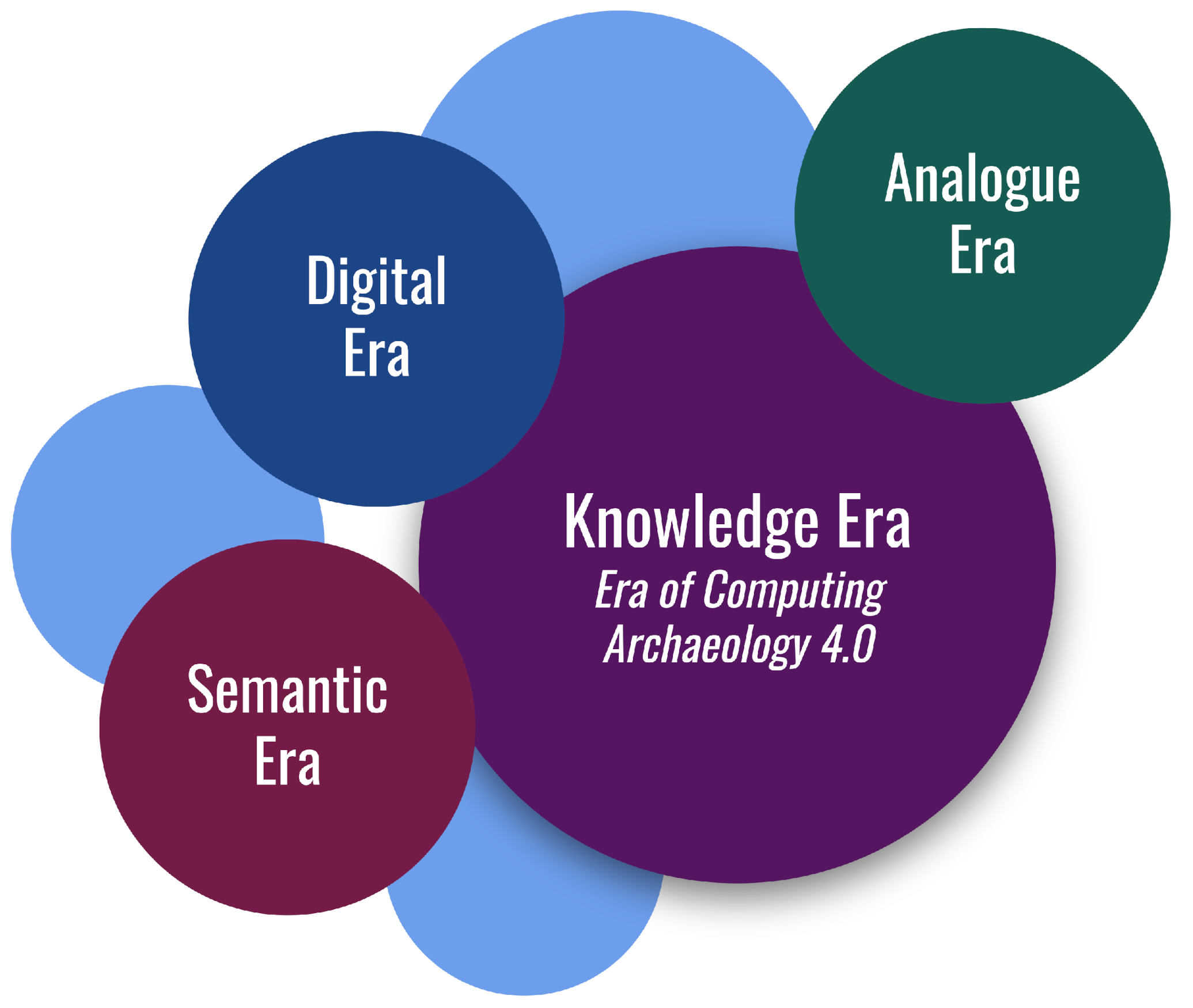
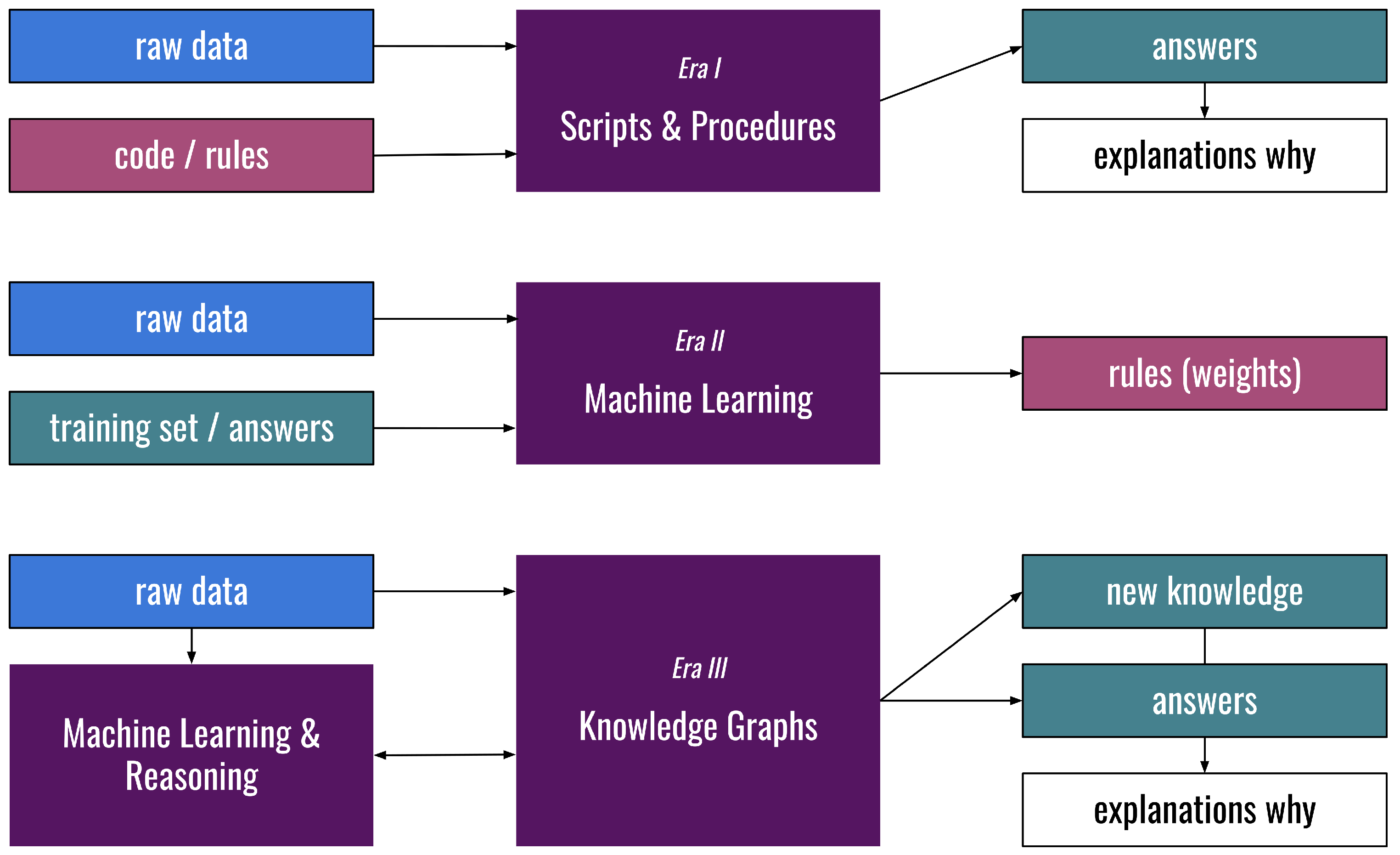
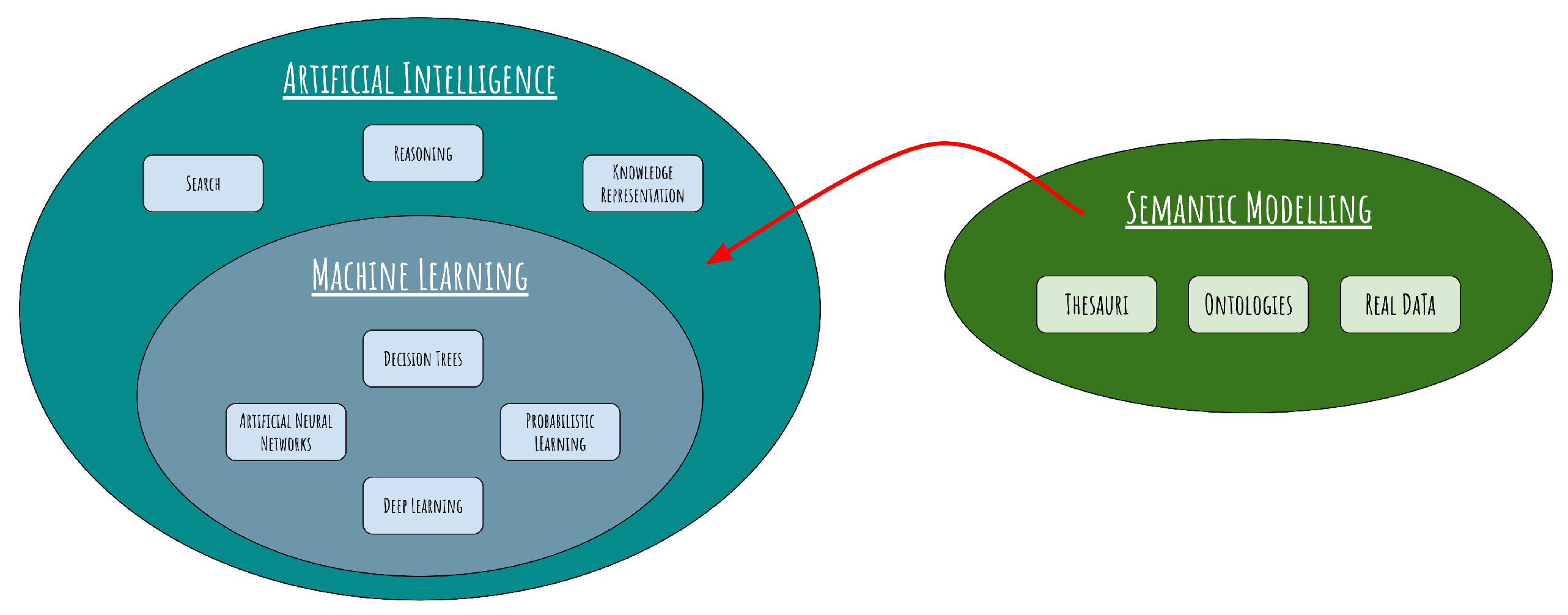
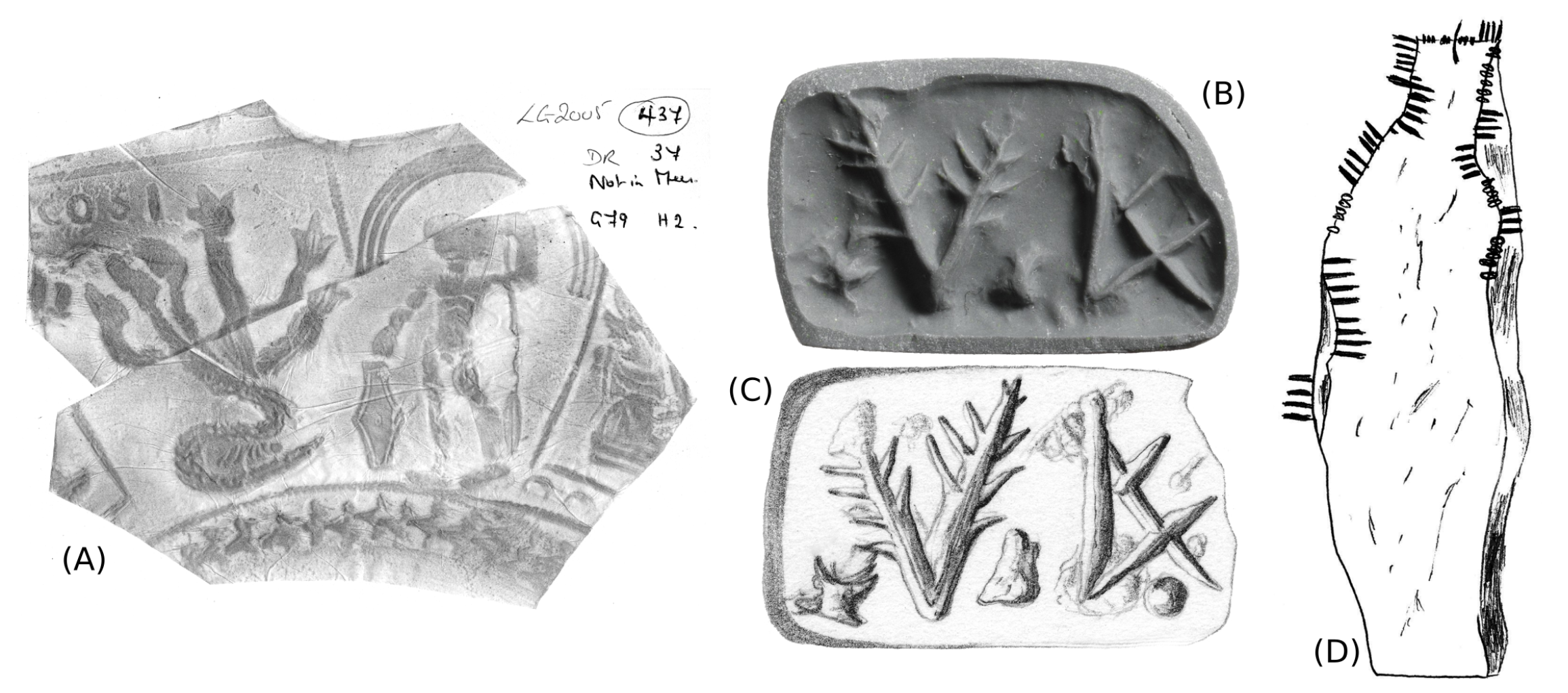
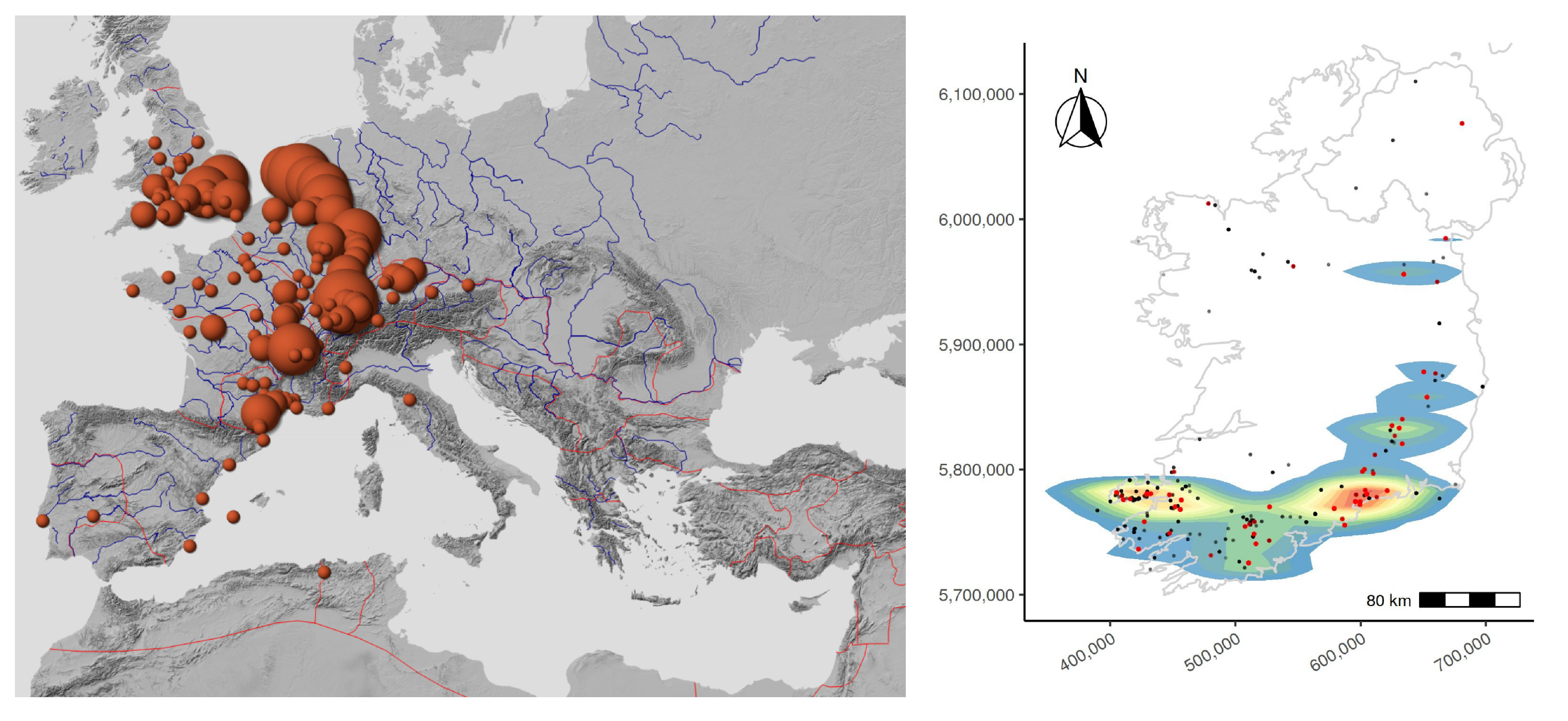
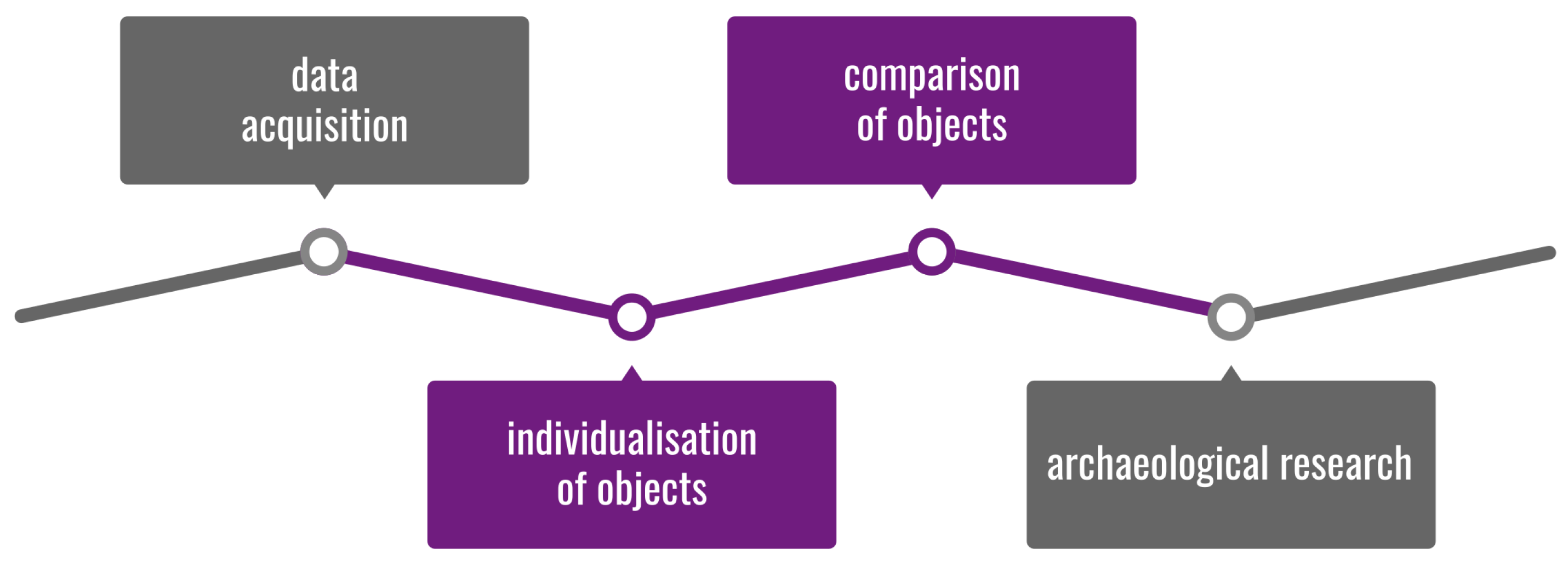
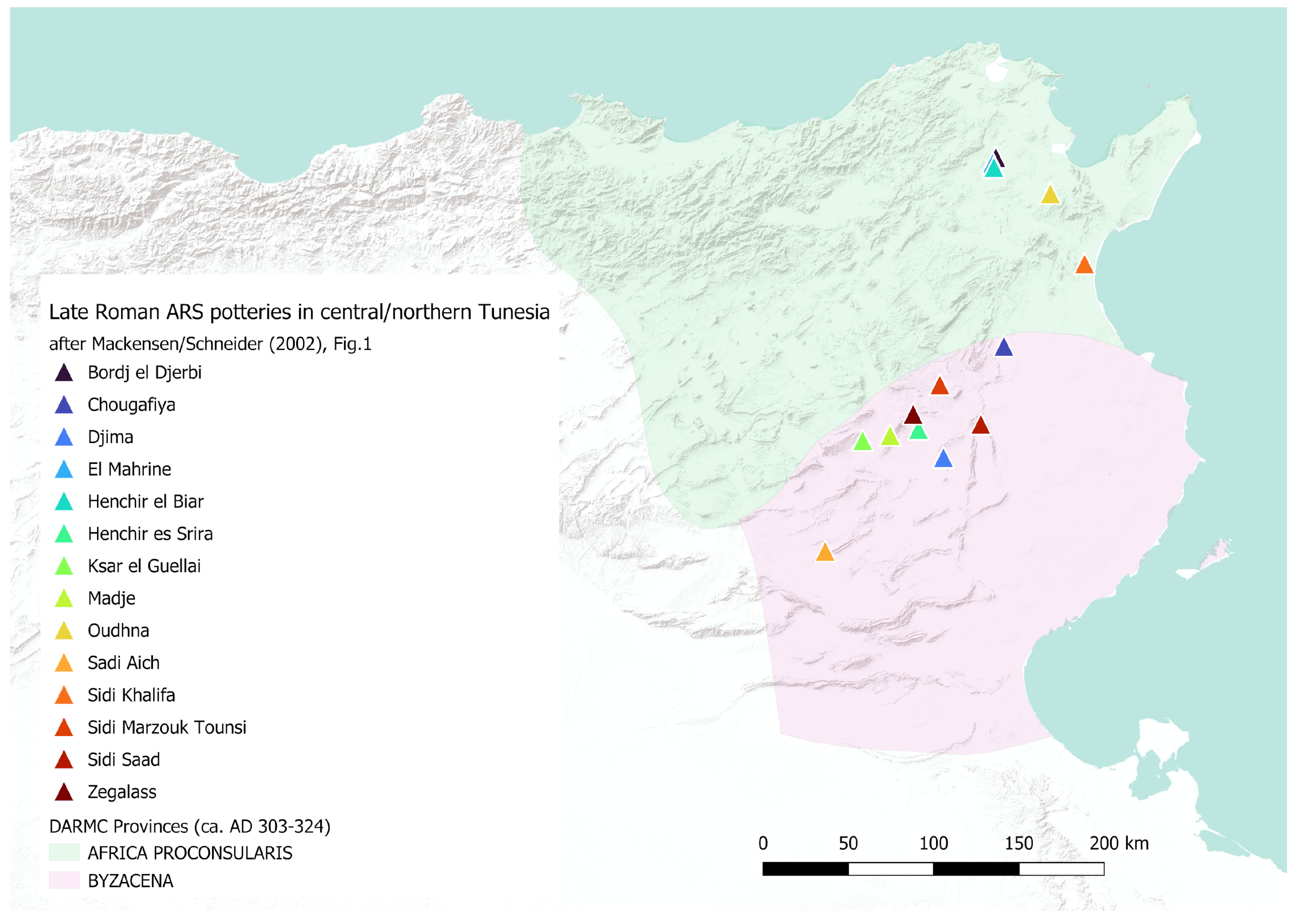
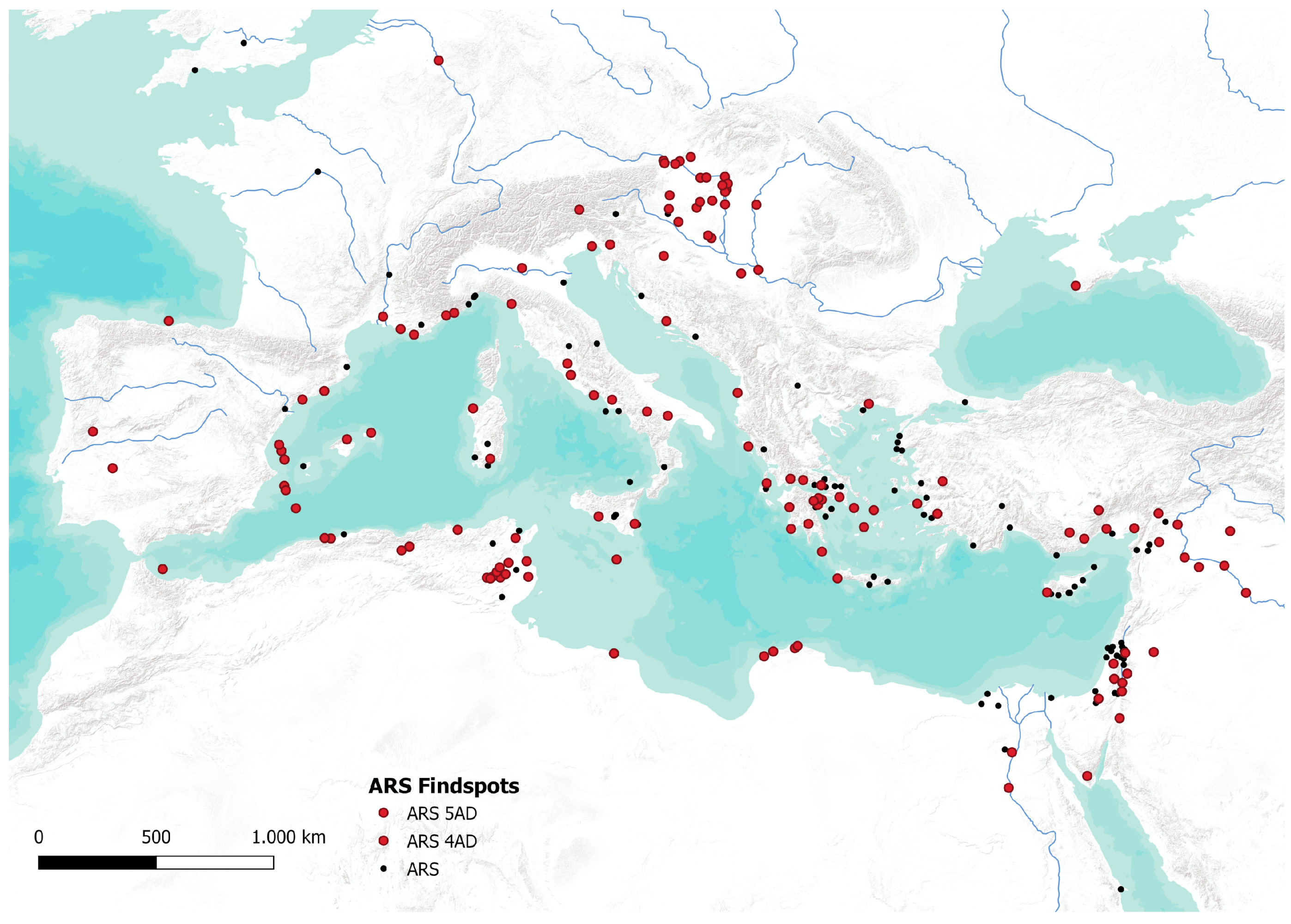

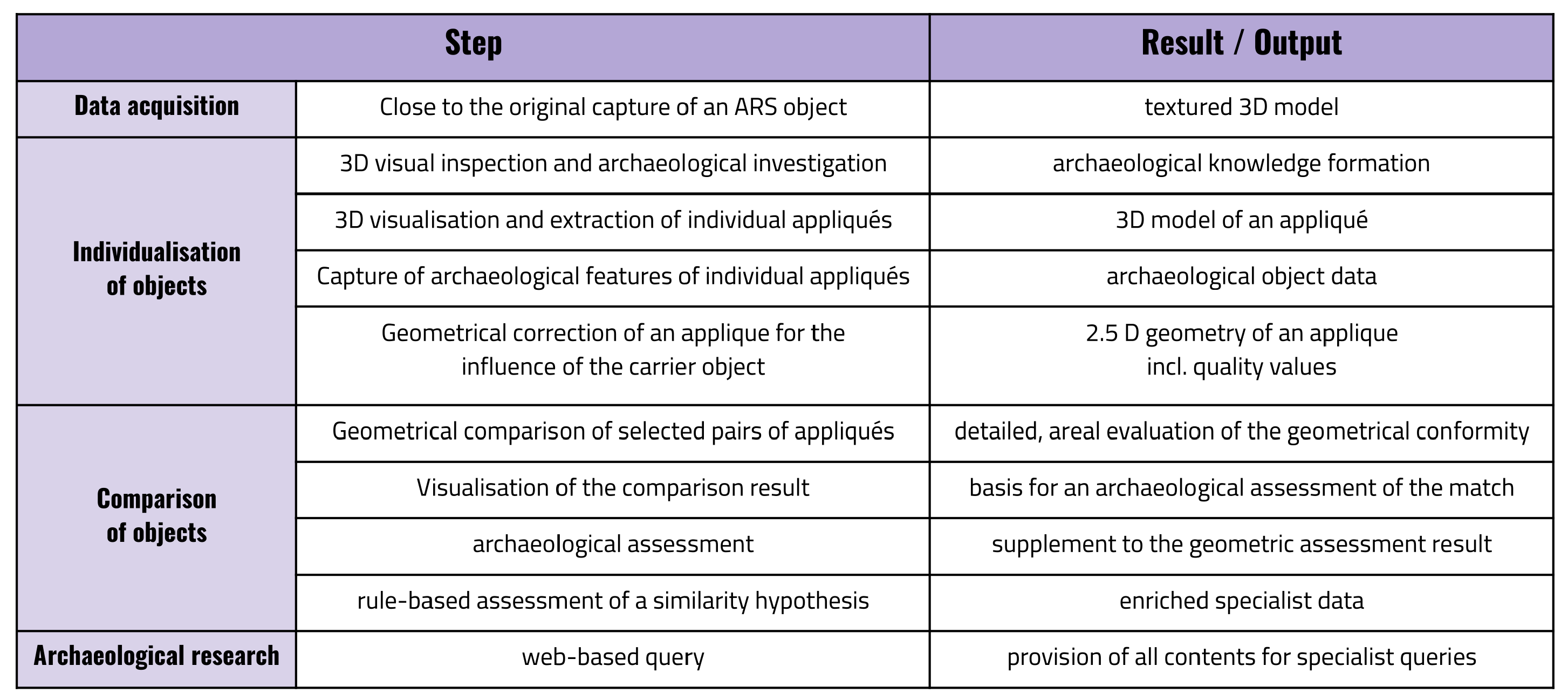
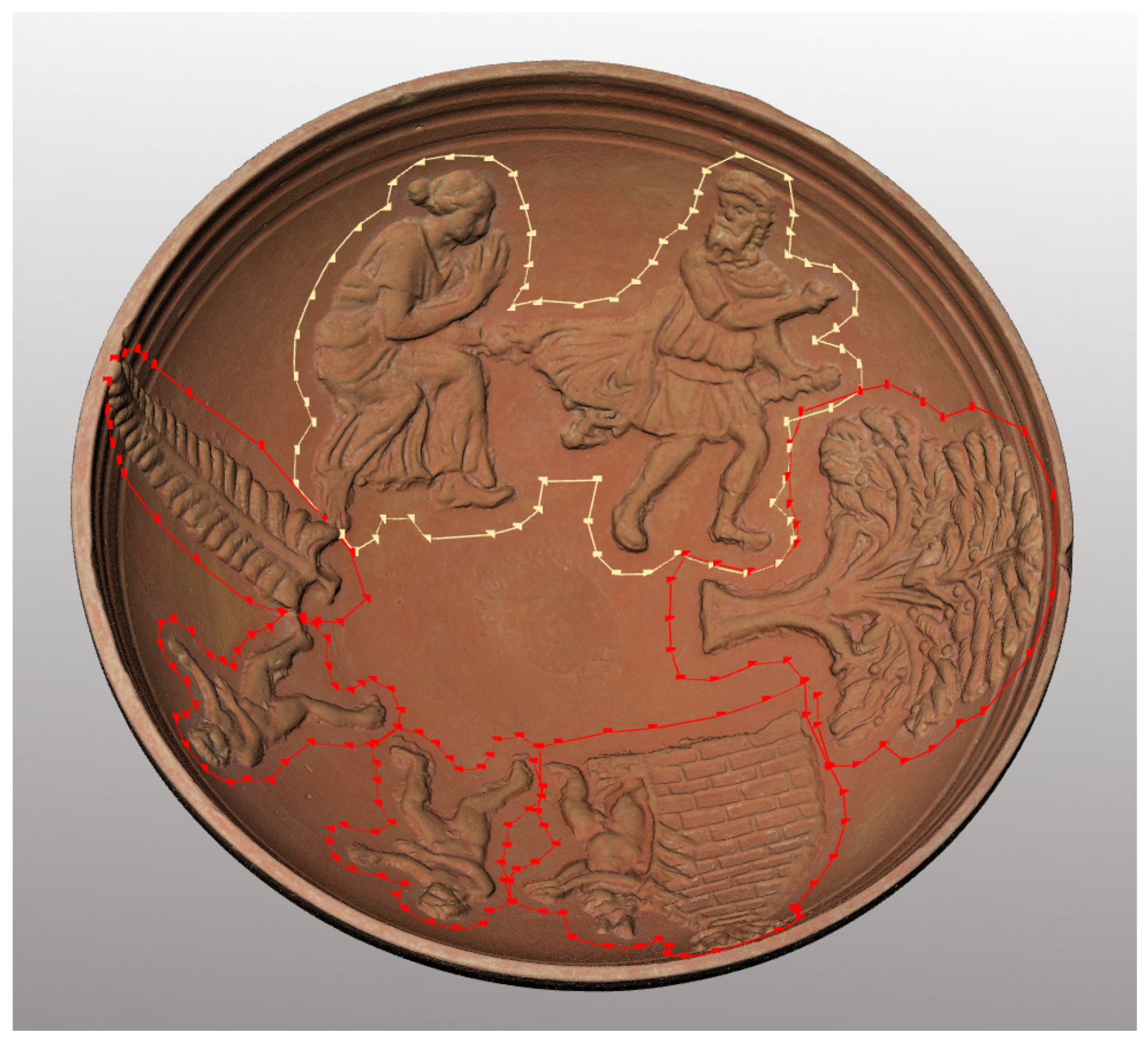

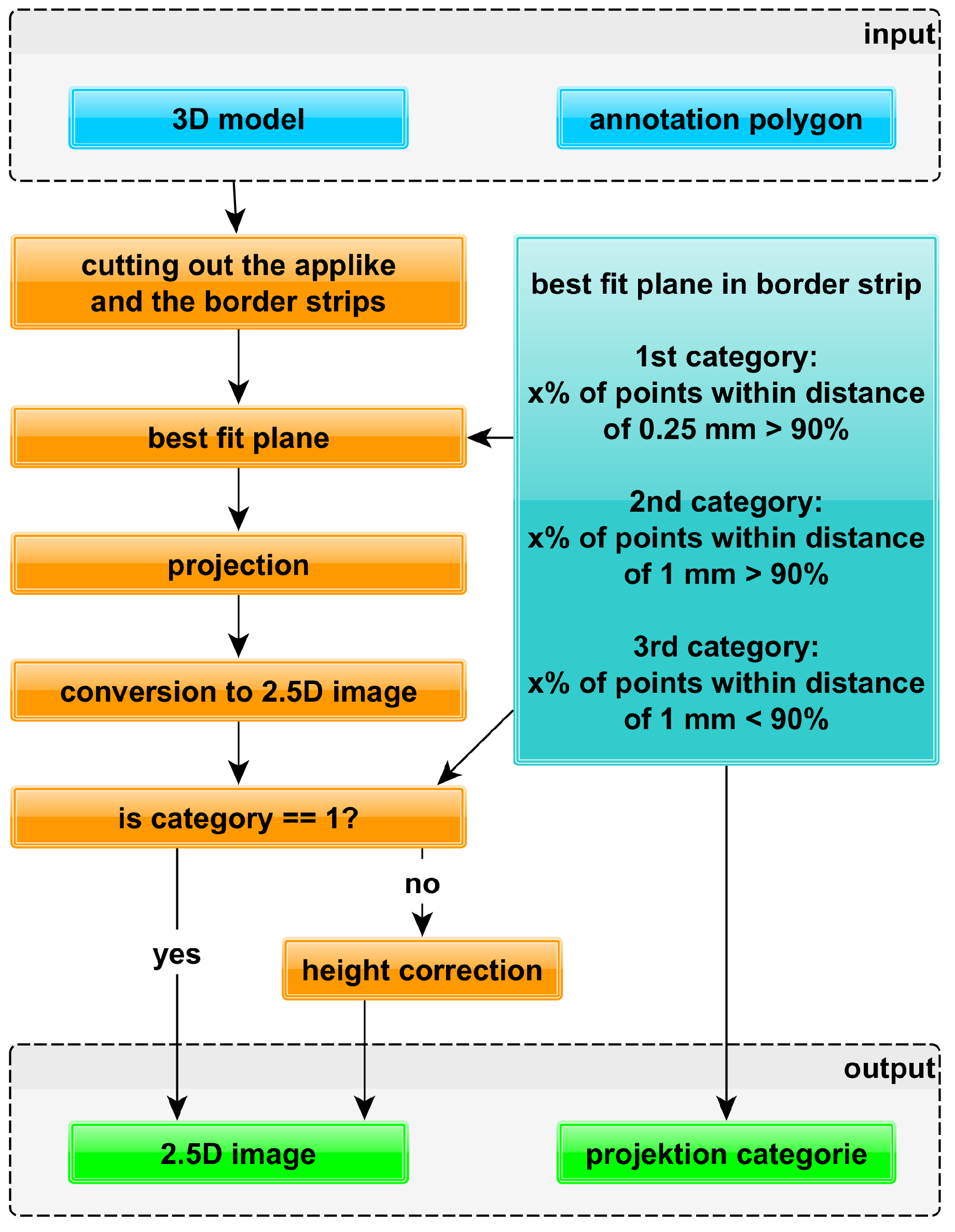
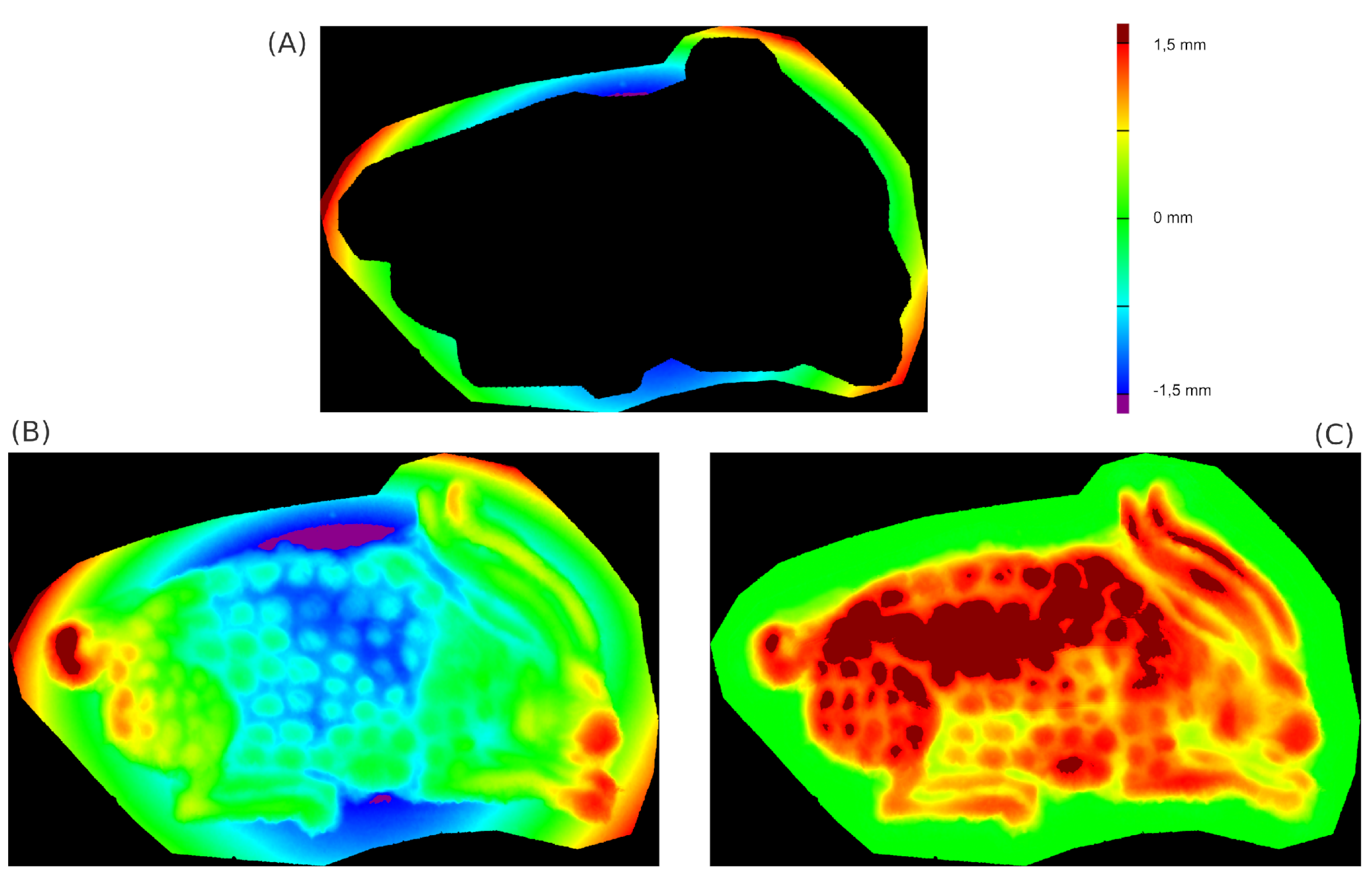
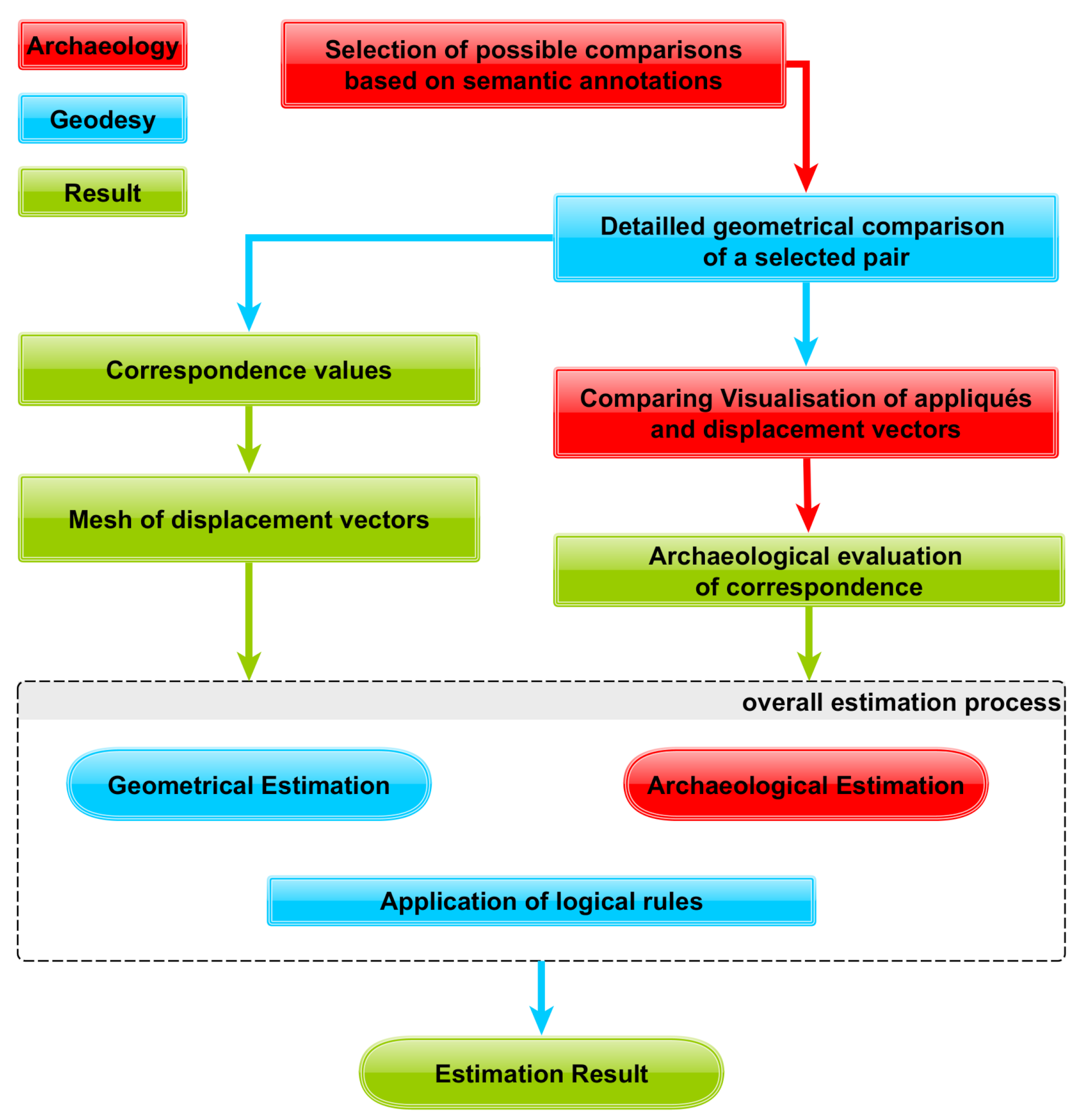

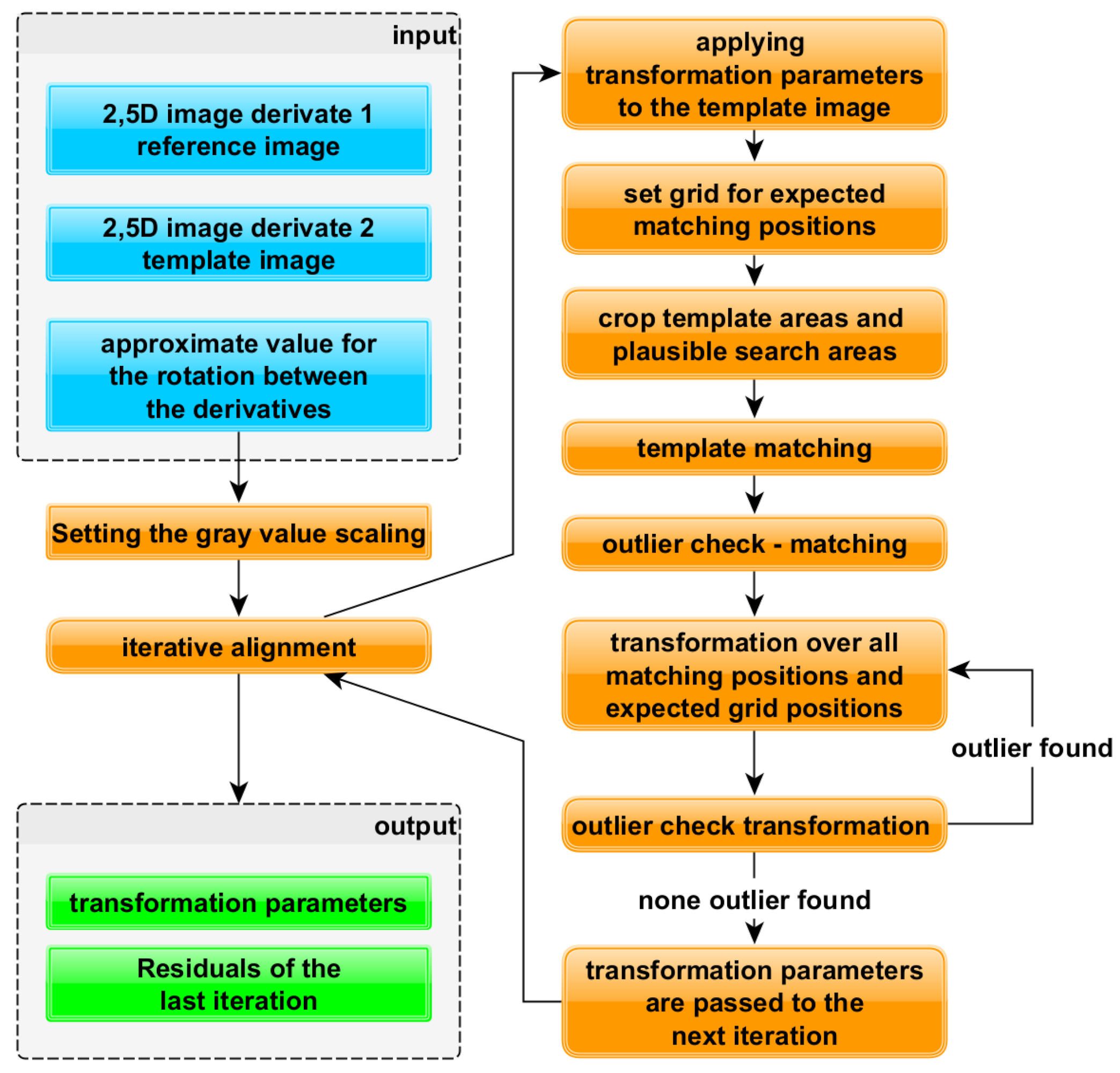
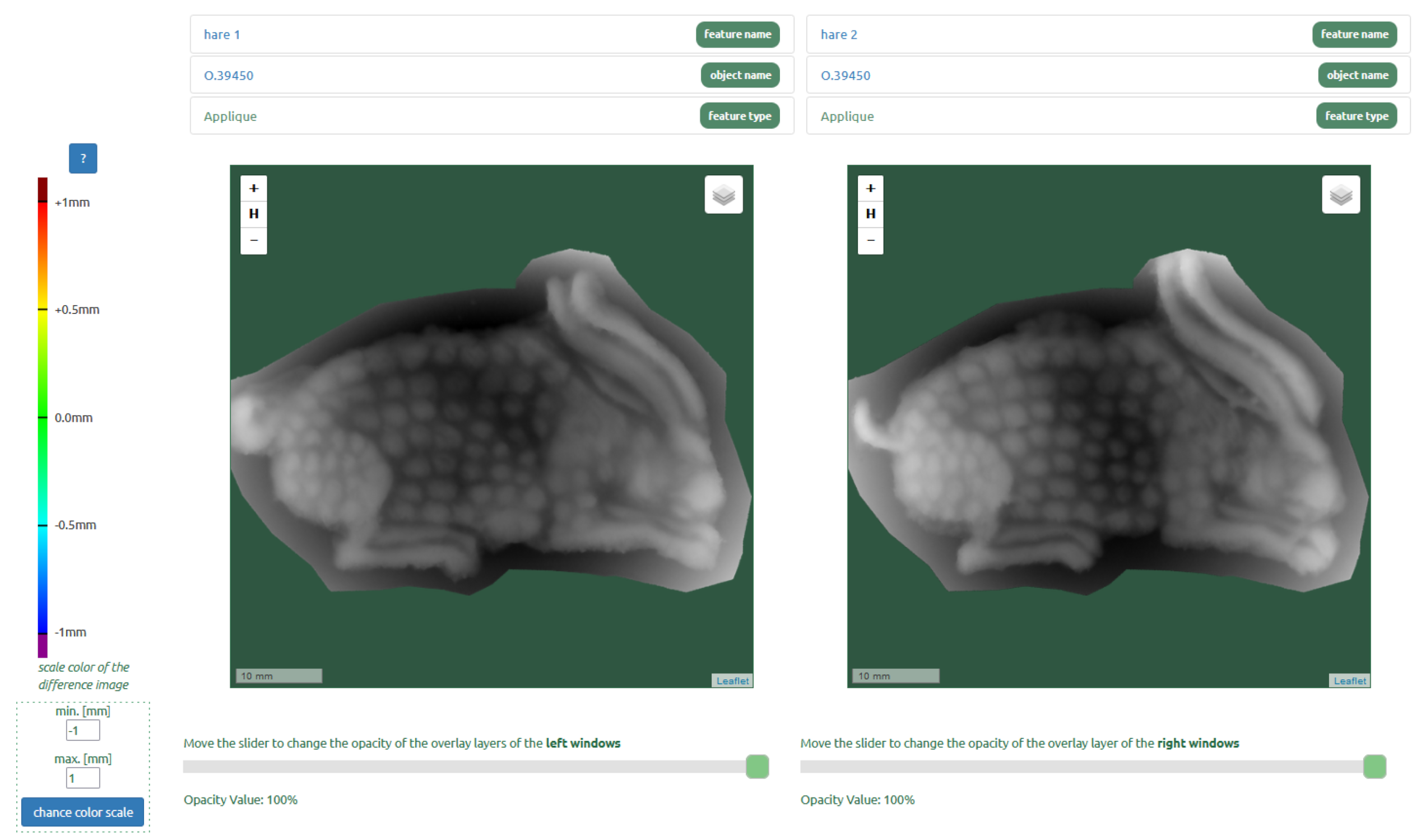


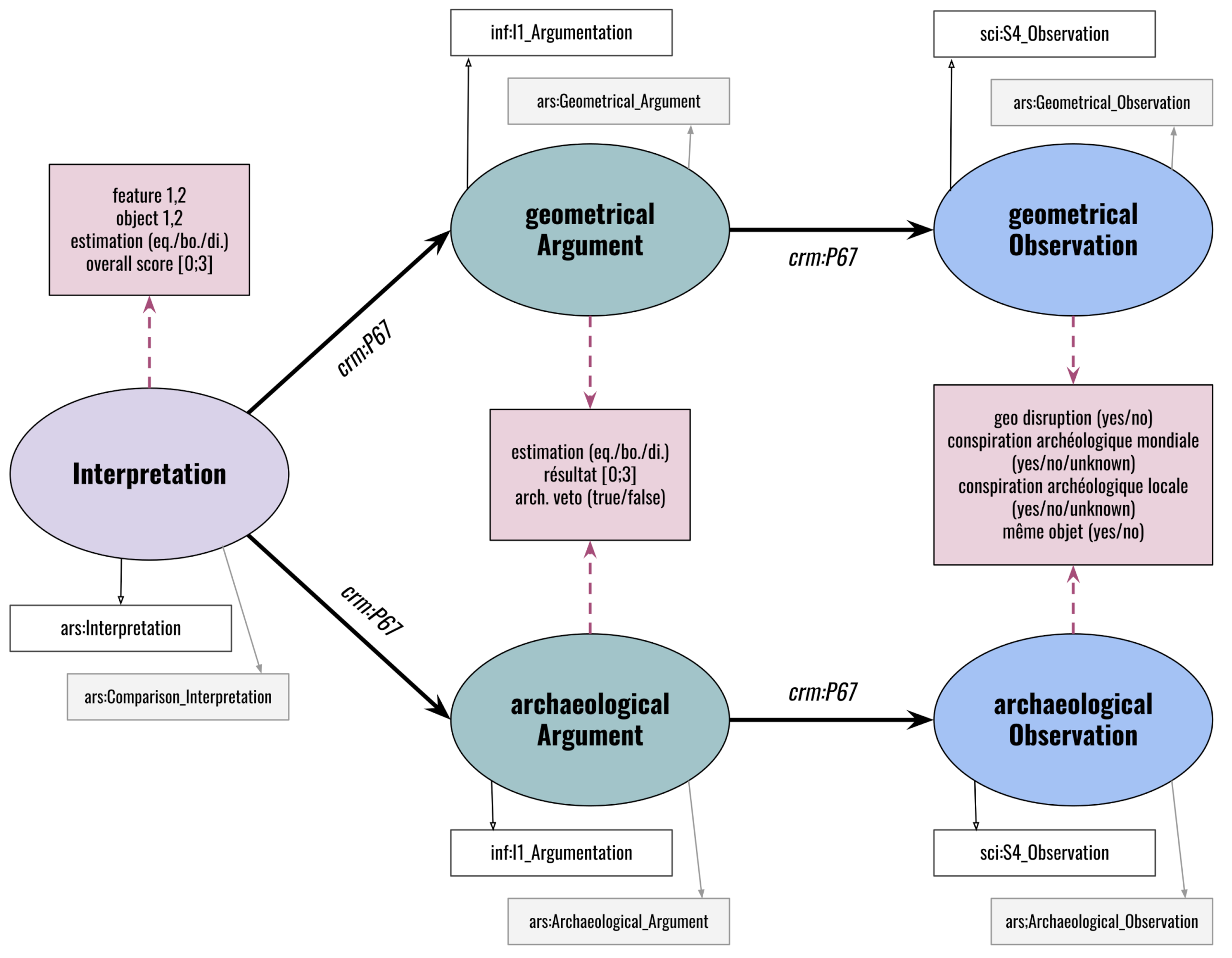
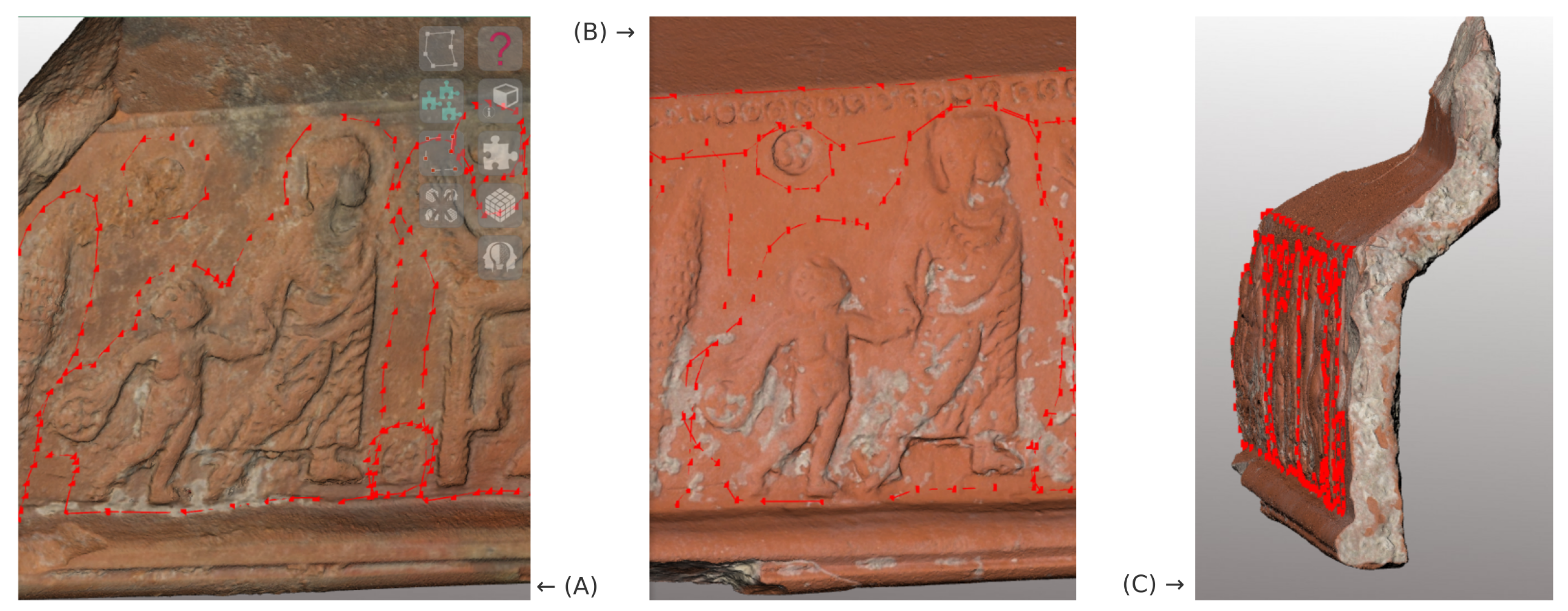
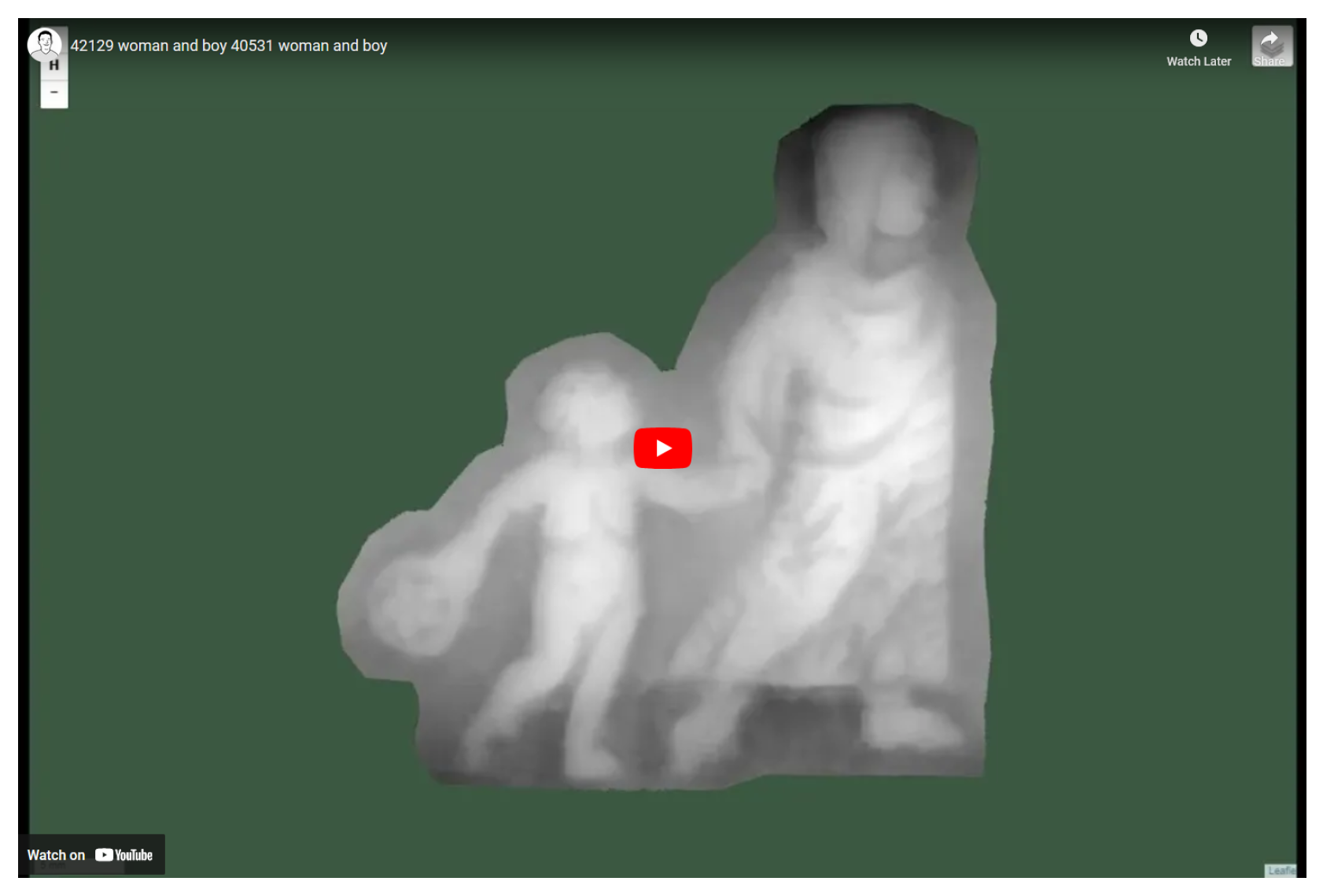
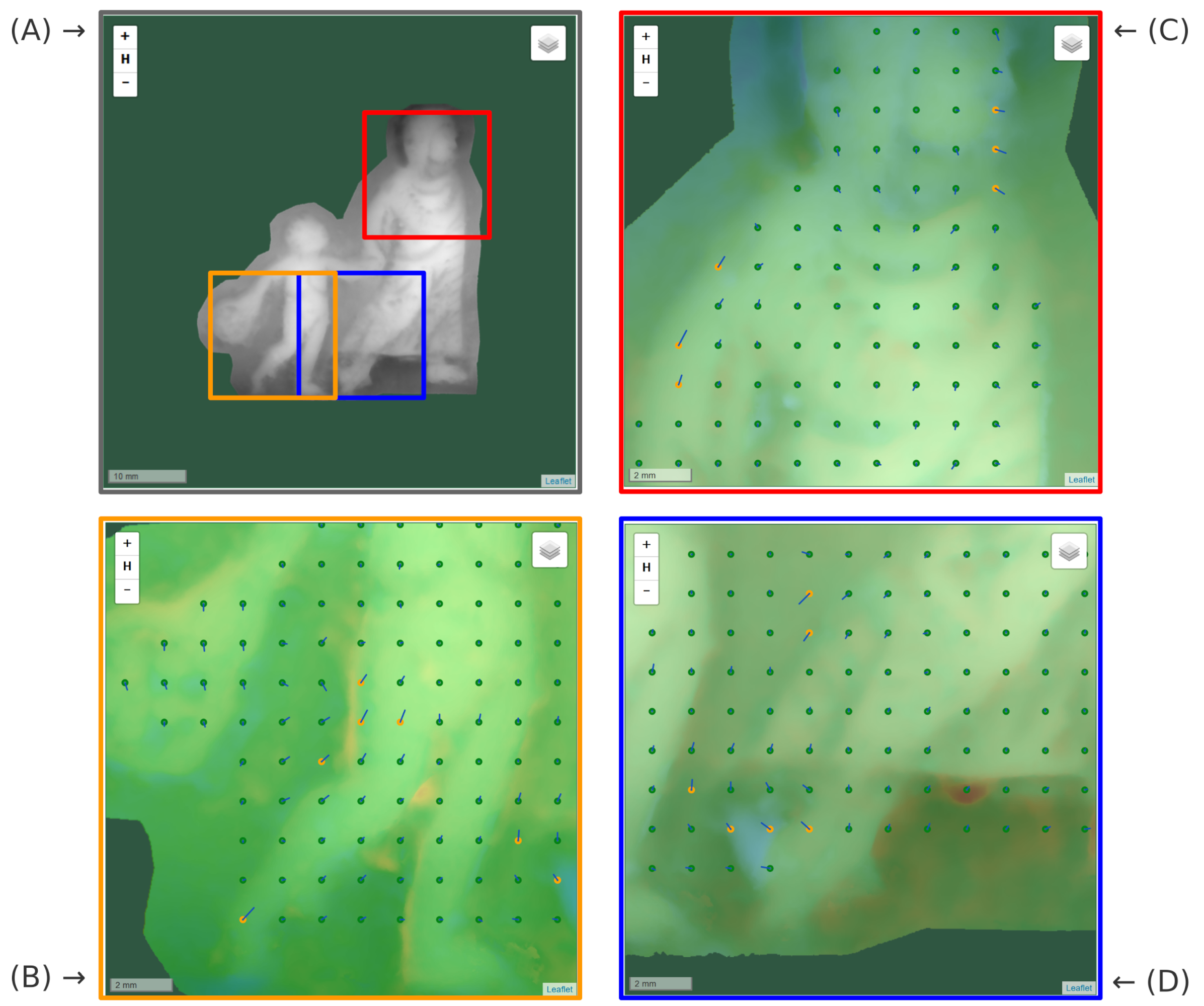
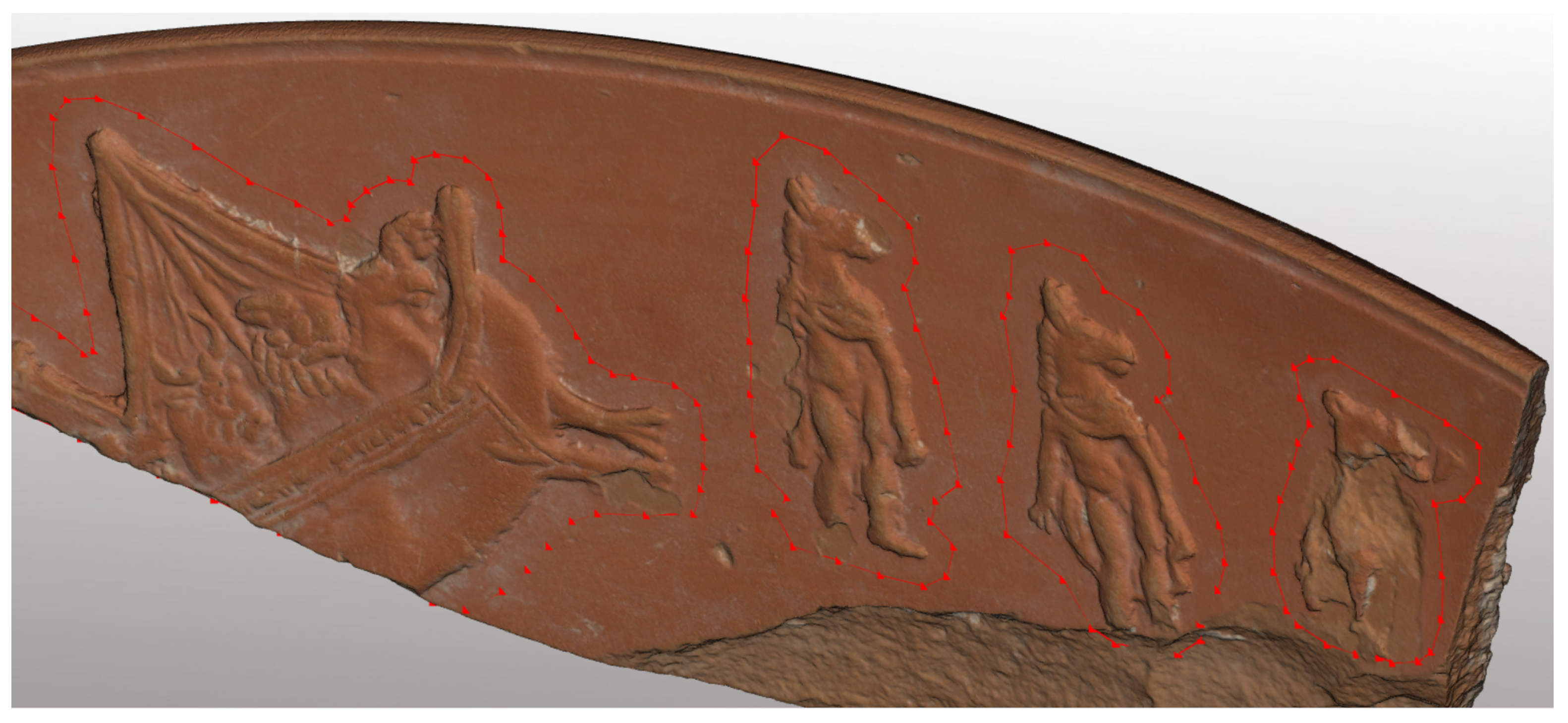

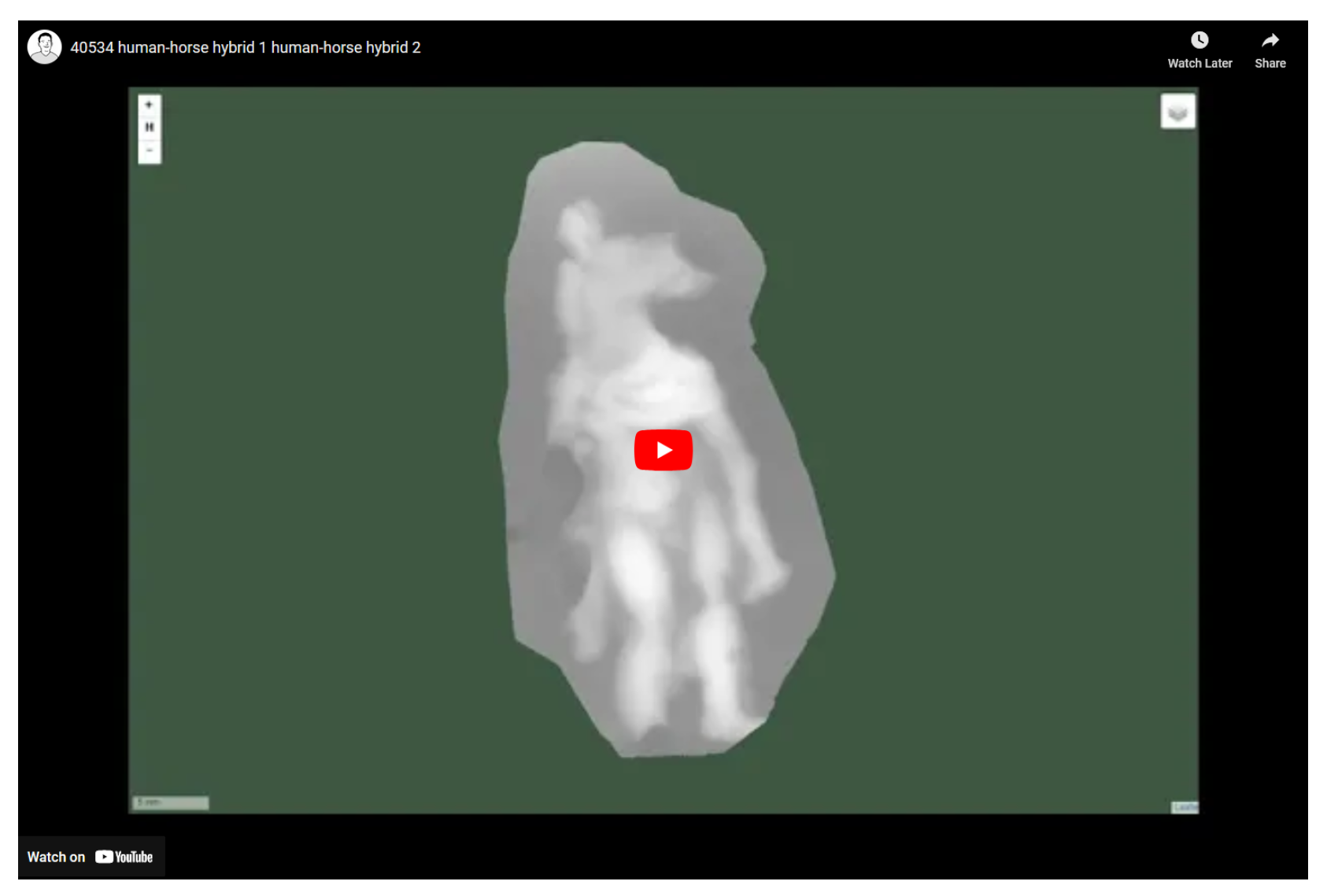
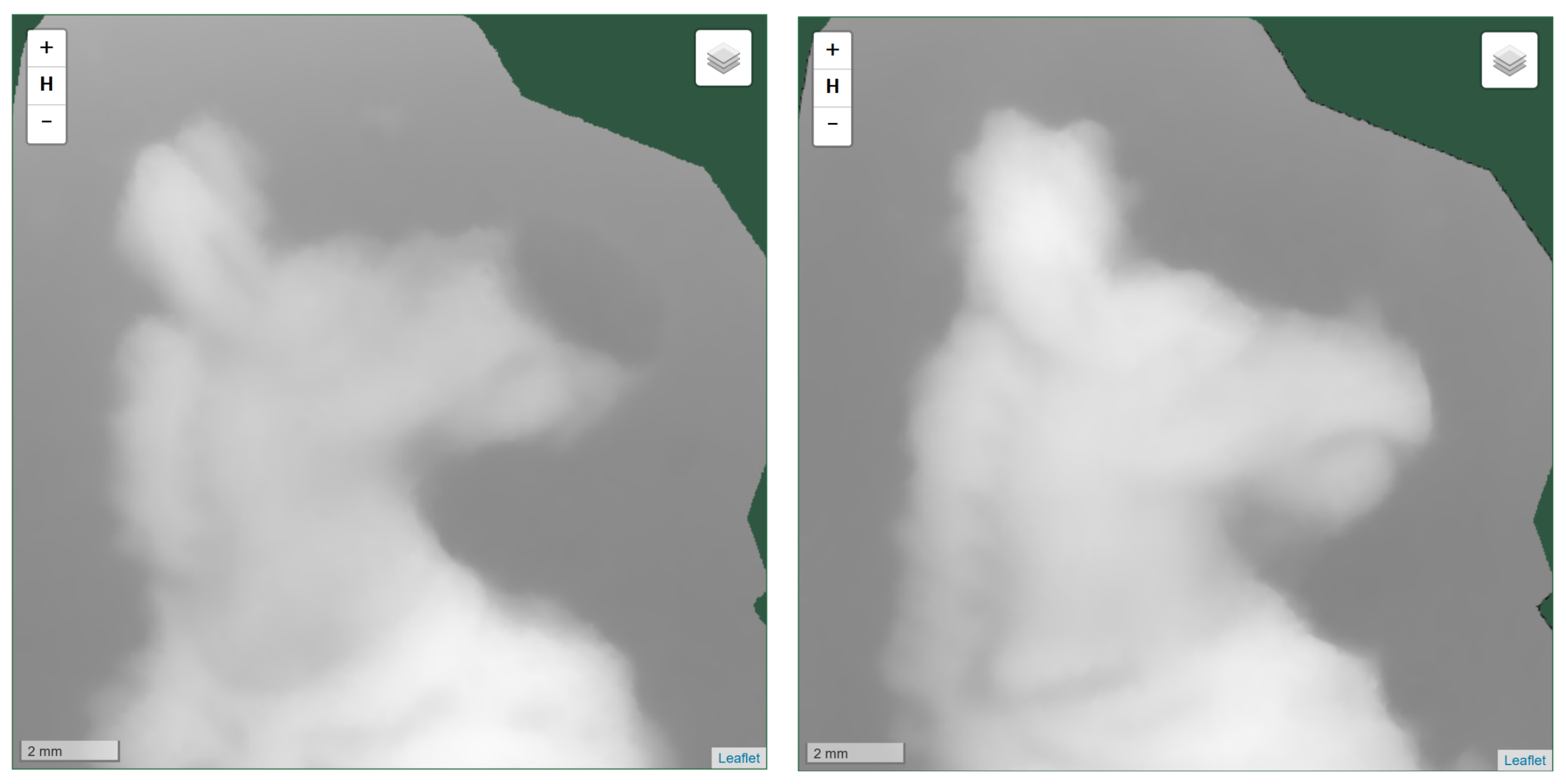

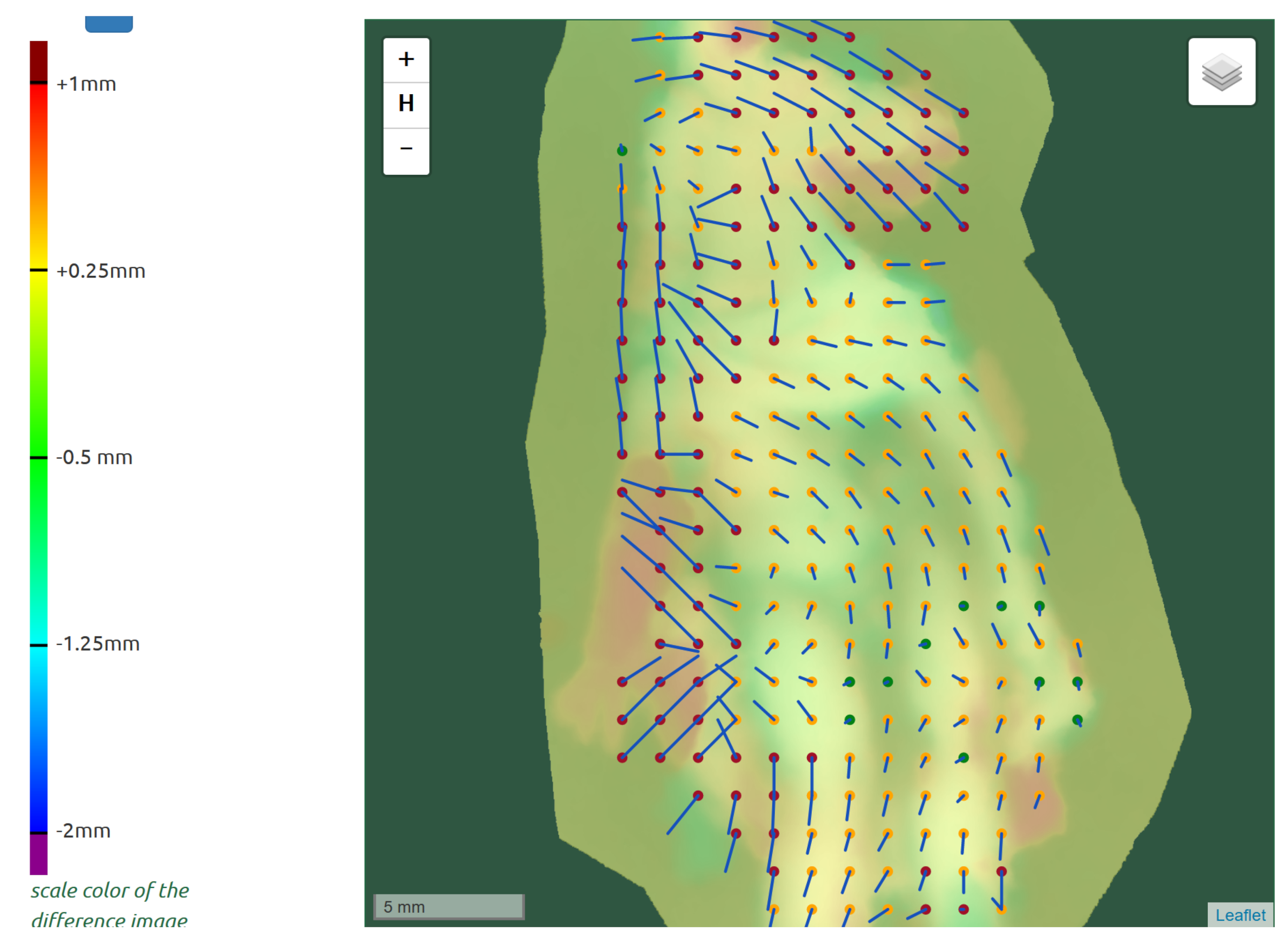
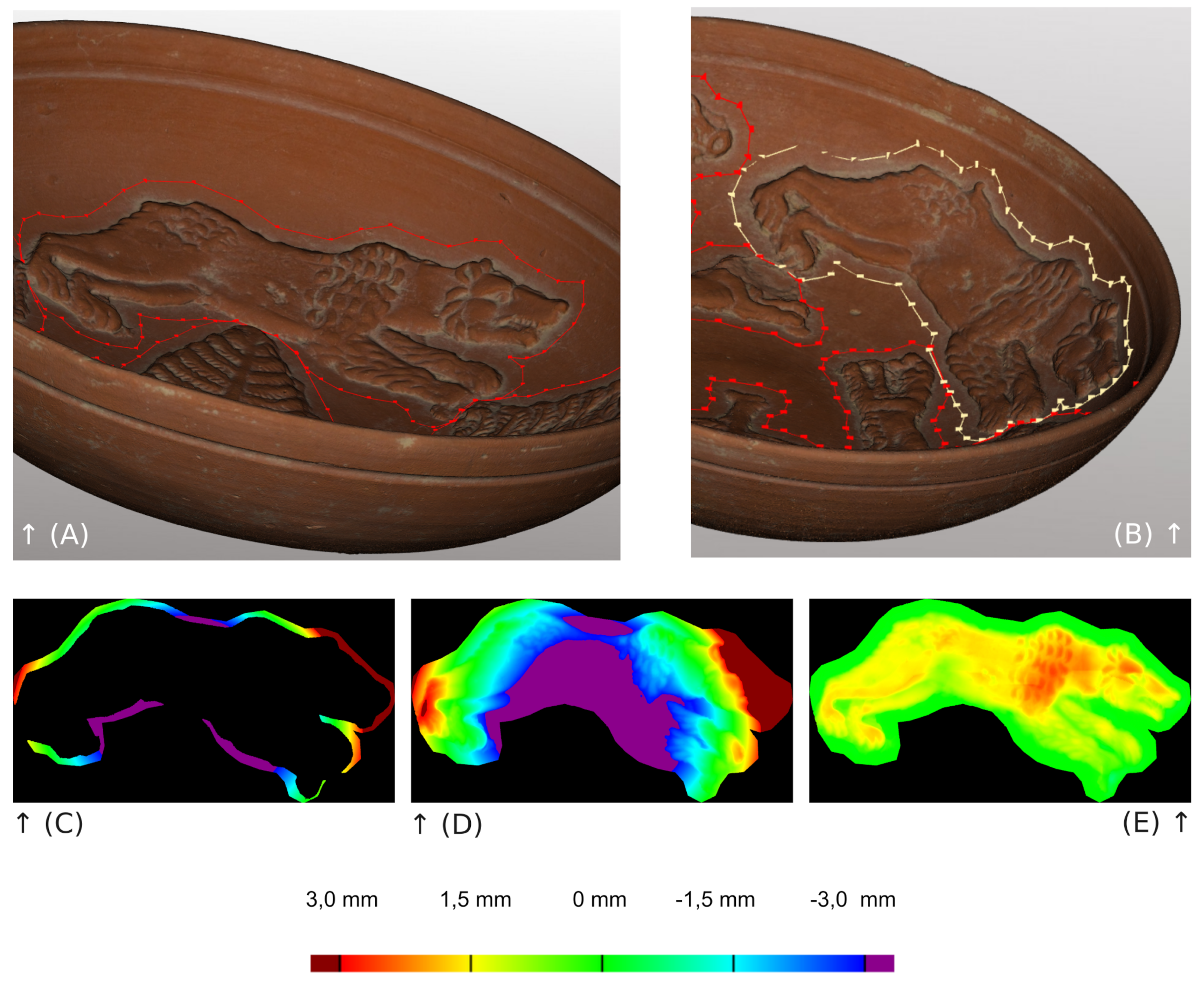
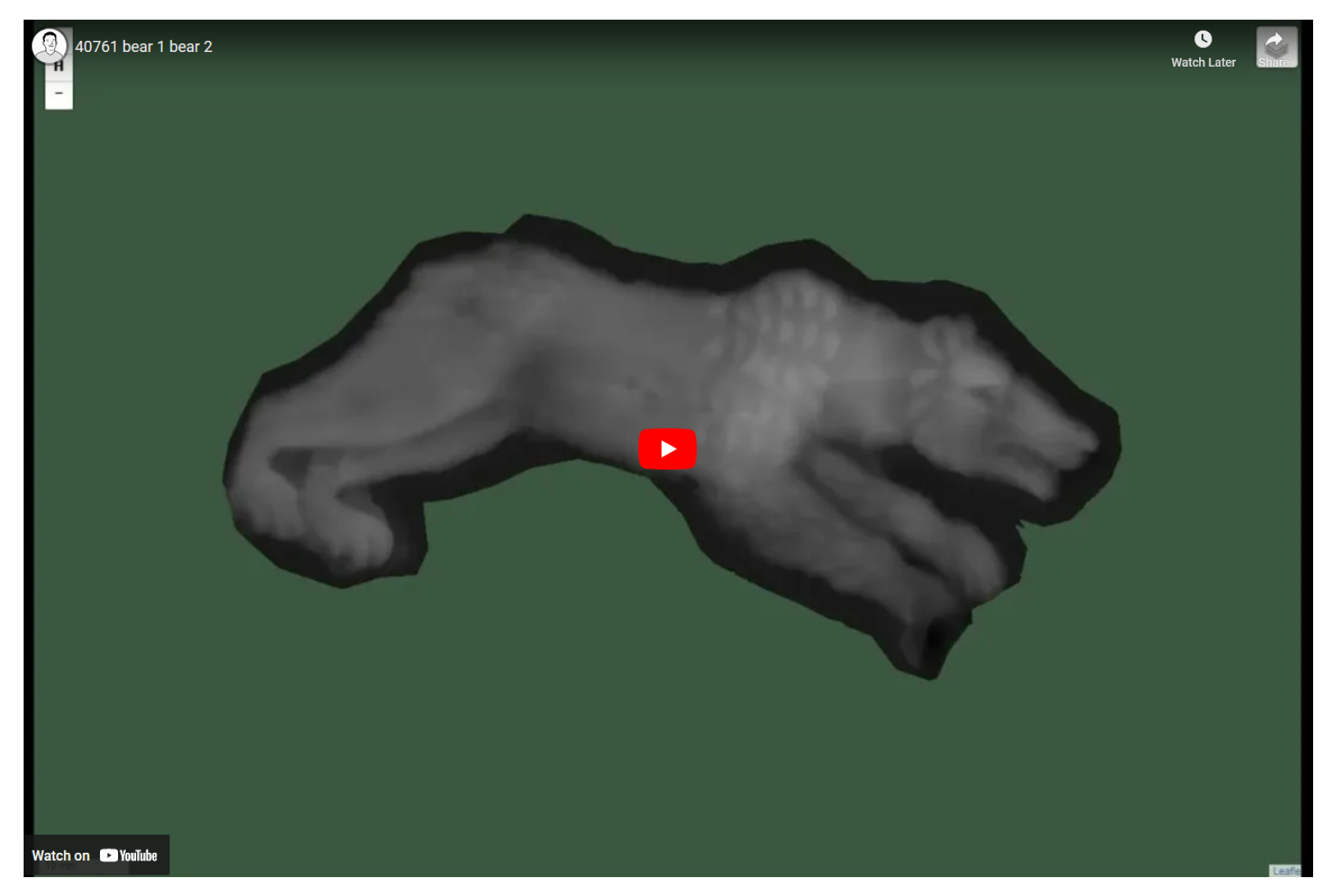
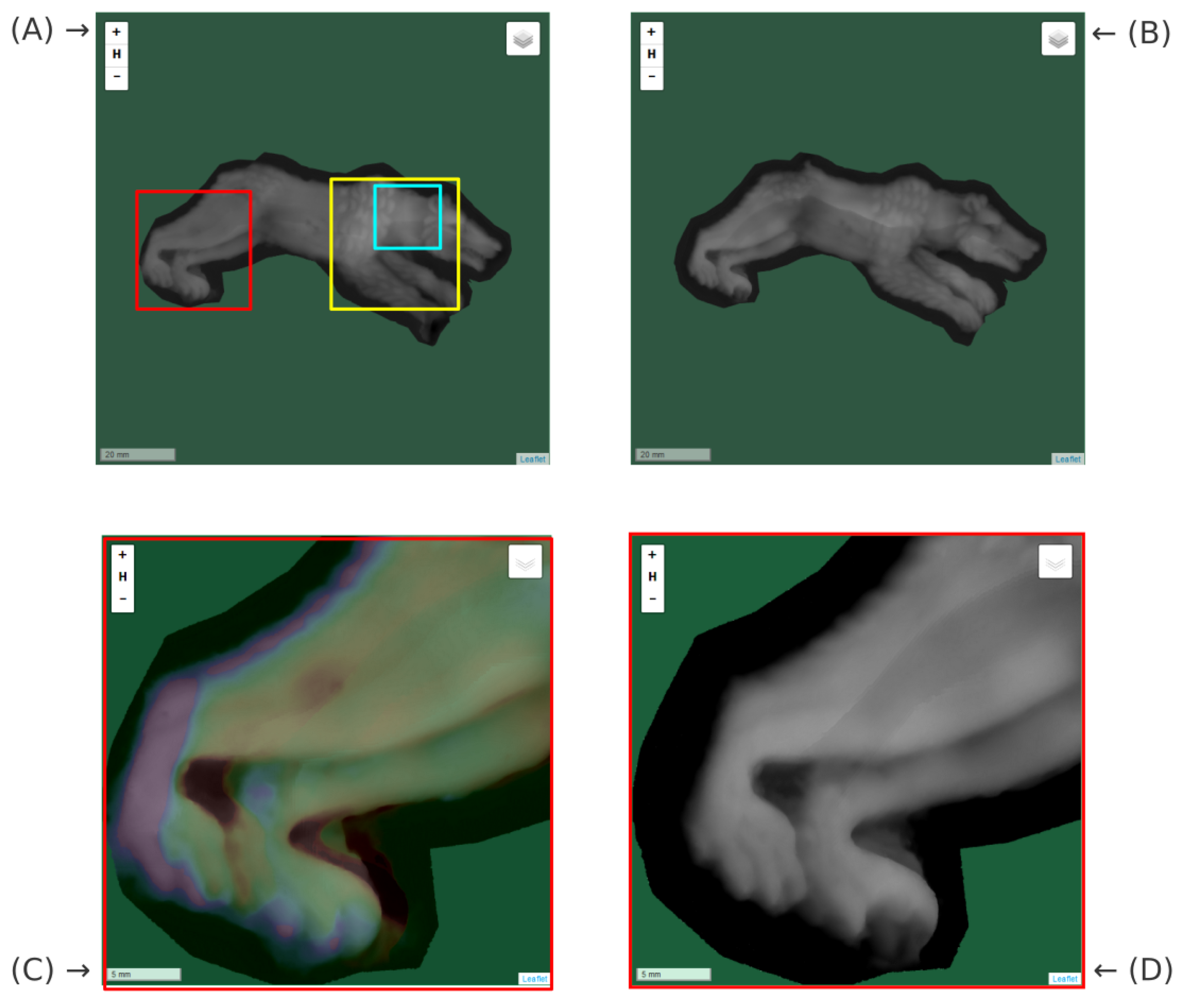
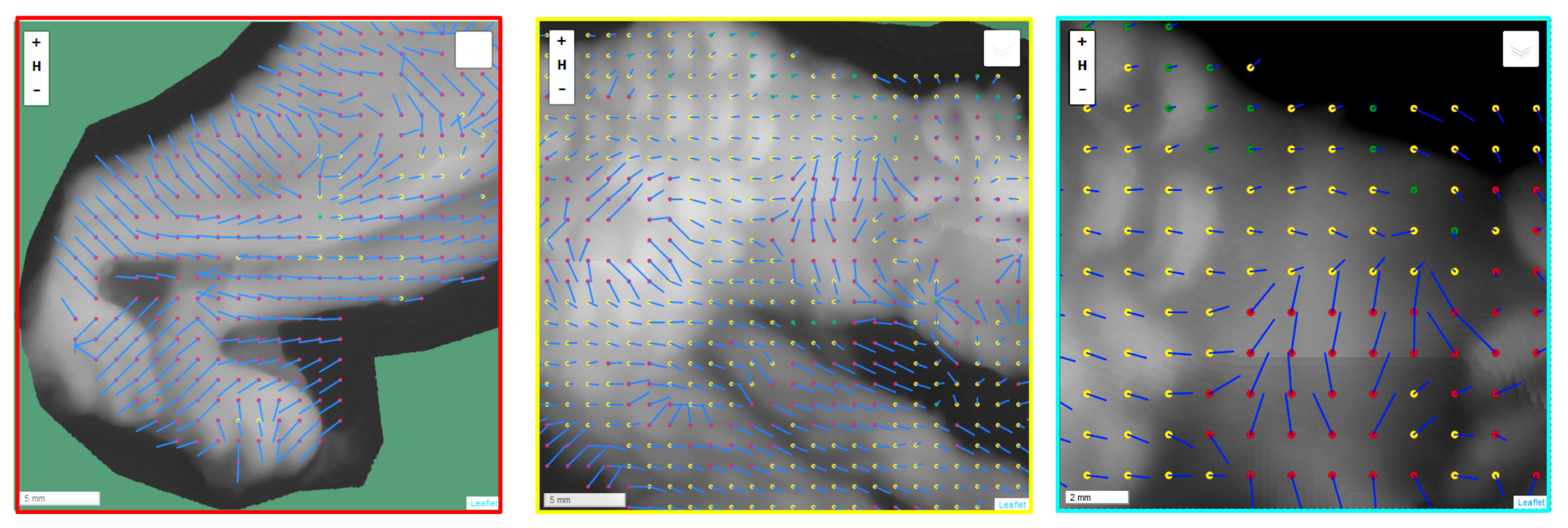
Disclaimer/Publisher’s Note: The statements, opinions and data contained in all publications are solely those of the individual author(s) and contributor(s) and not of MDPI and/or the editor(s). MDPI and/or the editor(s) disclaim responsibility for any injury to people or property resulting from any ideas, methods, instructions or products referred to in the content. |
© 2023 by the authors. Licensee MDPI, Basel, Switzerland. This article is an open access article distributed under the terms and conditions of the Creative Commons Attribution (CC BY) license (https://creativecommons.org/licenses/by/4.0/).
Share and Cite
Thiery, F.; Veller, J.; Raddatz, L.; Rokohl, L.; Boochs, F.; Mees, A.W. A Semi-Automatic Semantic-Model-Based Comparison Workflow for Archaeological Features on Roman Ceramics. ISPRS Int. J. Geo-Inf. 2023, 12, 167. https://doi.org/10.3390/ijgi12040167
Thiery F, Veller J, Raddatz L, Rokohl L, Boochs F, Mees AW. A Semi-Automatic Semantic-Model-Based Comparison Workflow for Archaeological Features on Roman Ceramics. ISPRS International Journal of Geo-Information. 2023; 12(4):167. https://doi.org/10.3390/ijgi12040167
Chicago/Turabian StyleThiery, Florian, Jonas Veller, Laura Raddatz, Louise Rokohl, Frank Boochs, and Allard W. Mees. 2023. "A Semi-Automatic Semantic-Model-Based Comparison Workflow for Archaeological Features on Roman Ceramics" ISPRS International Journal of Geo-Information 12, no. 4: 167. https://doi.org/10.3390/ijgi12040167
APA StyleThiery, F., Veller, J., Raddatz, L., Rokohl, L., Boochs, F., & Mees, A. W. (2023). A Semi-Automatic Semantic-Model-Based Comparison Workflow for Archaeological Features on Roman Ceramics. ISPRS International Journal of Geo-Information, 12(4), 167. https://doi.org/10.3390/ijgi12040167







